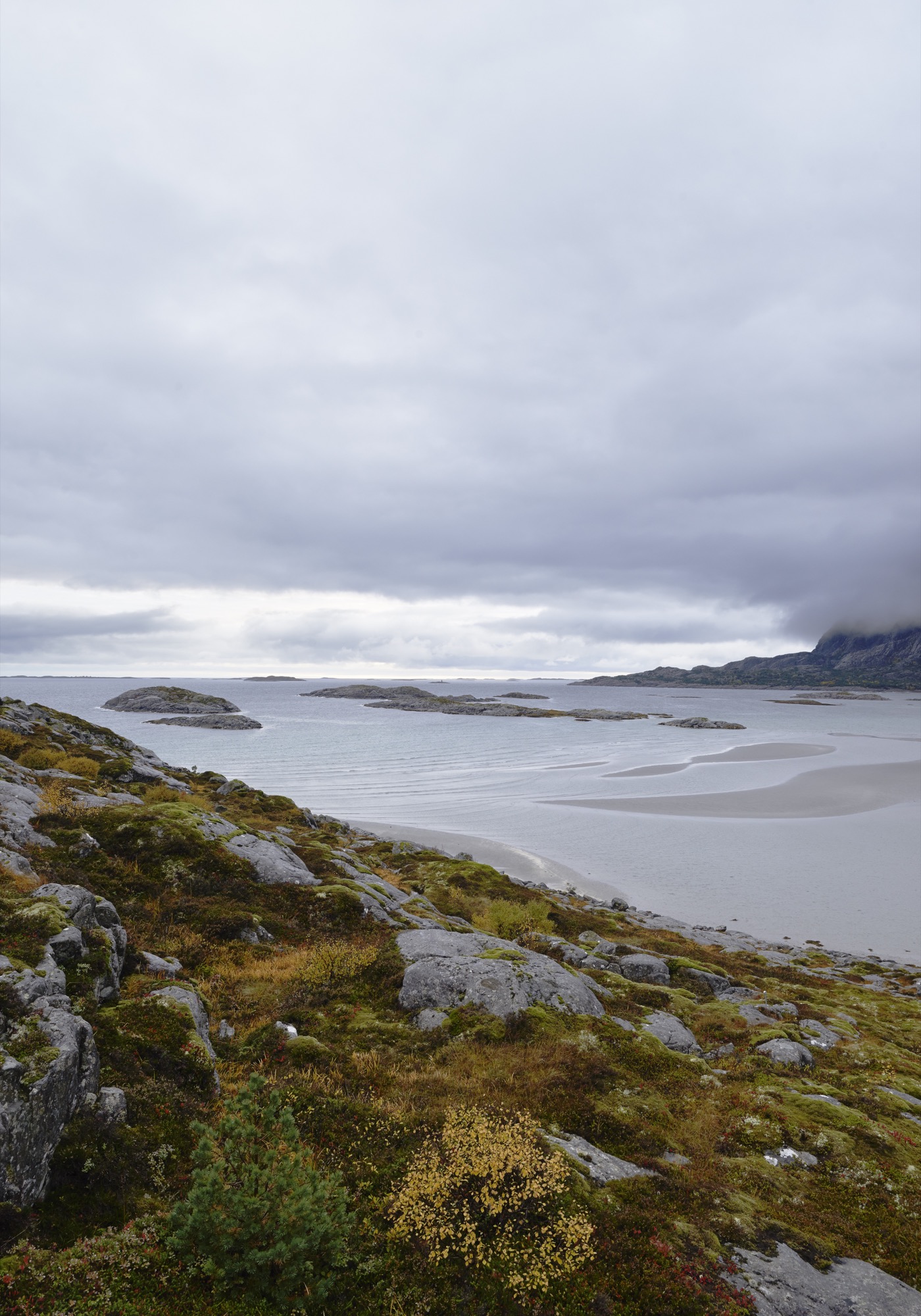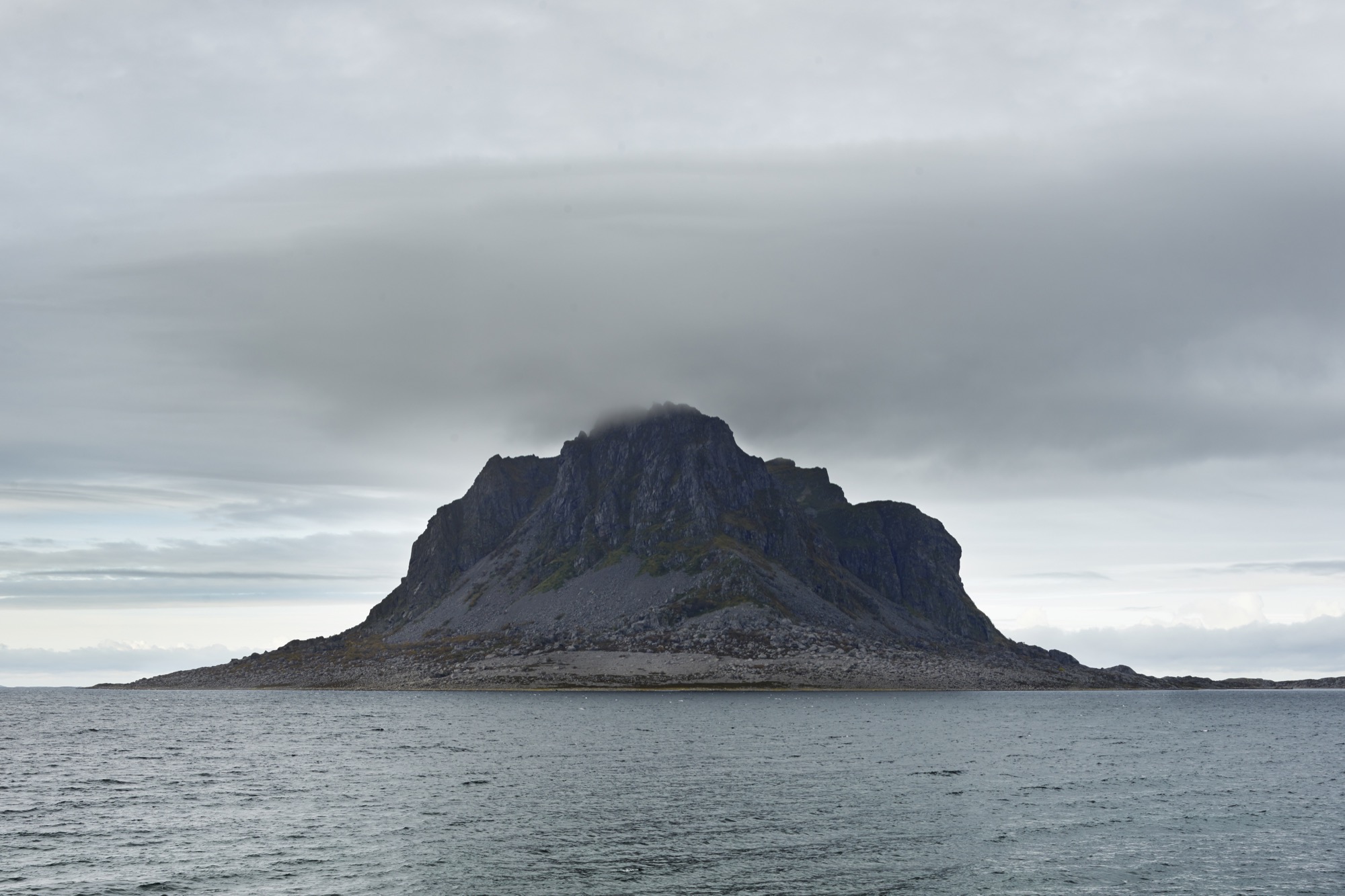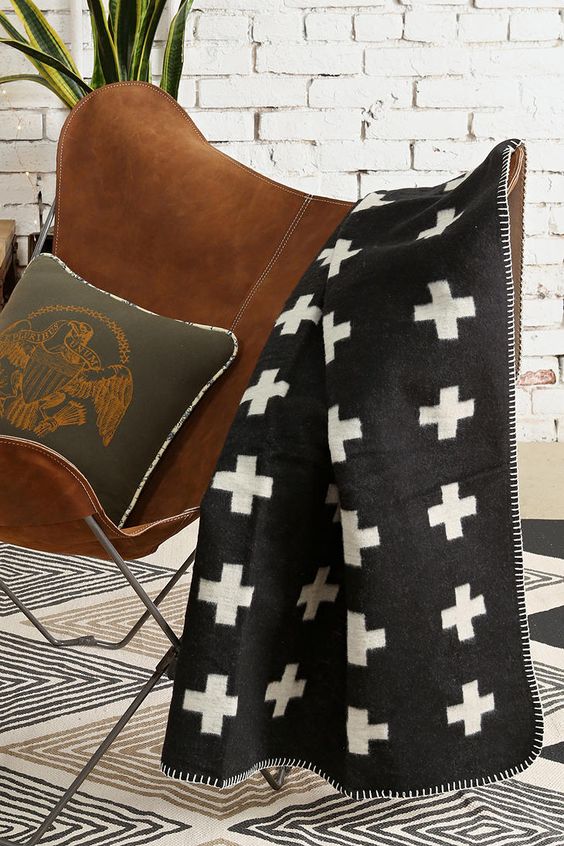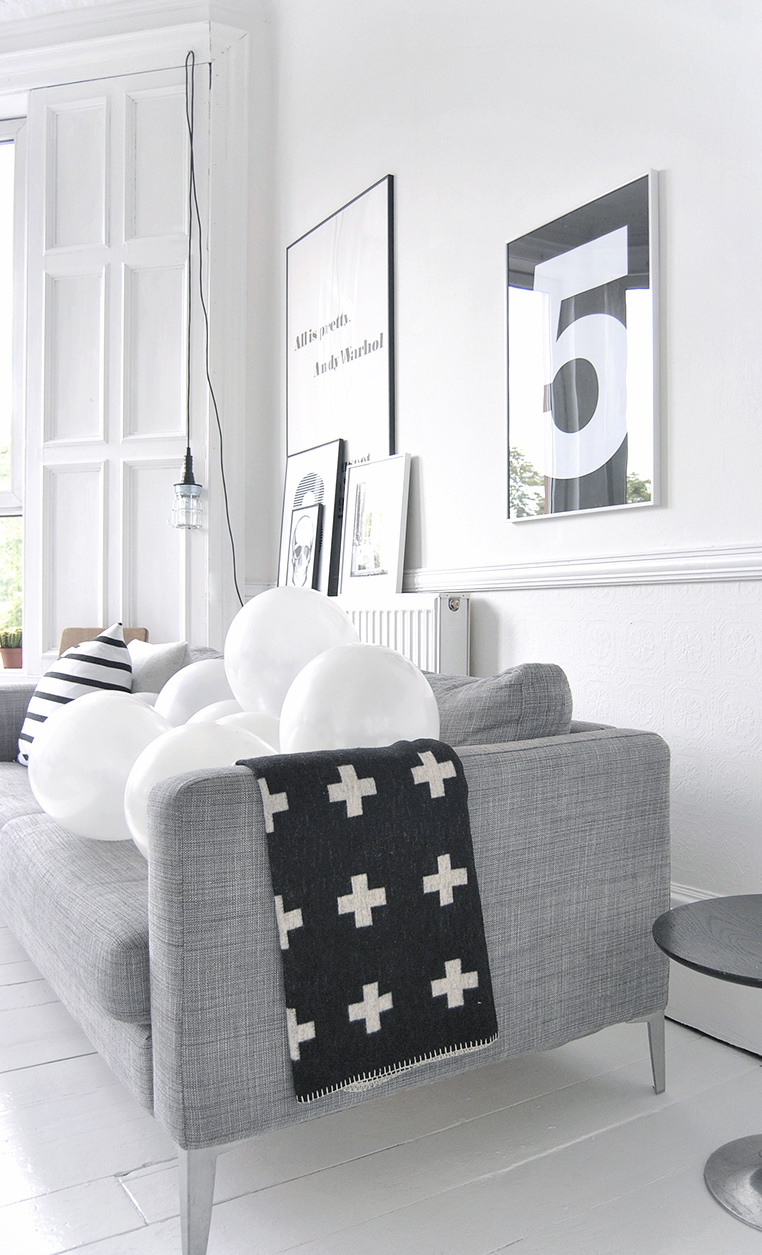
Inspirations
Explore the elevated life in the mountains. This content debuted in 2015 with Alpine Modern’s printed quarterly magazine project.
Scandinavia Trip Itinerary
When fall comes each year we find ourselves cleaning house, organizing, downsizing, and taking stock of the beautiful sunny memories of summer. As the kids nap peacefully this afternoon, we're snuggled on the couch watching the last of the orange and yellow leaves of cottonwoods drift quietly in the backyard. We're taking this window of opportunity to send a special inspirations email today about our summer vacation to Scandinavia. Along with our two kids, we explored Denmark, Sweden, and Norway for three full weeks in July. There are plenty of luxury-focused travel guides like Monocle, CITYX, and the Michelin Nordic Guide that are excellent resources, but we wanted to share with you some of our favorite places from the trip. Many of these links will go to our website where we have included pictures and more details about our experiences:
Denmark
When we began our trip we planned a few days of doing nothing so that we could adjust to the time zone and enter vacation-mode. We rented an Airbnb home in Hellerup (just North of Copenhagen). The home is located in a quiet neighborhood which was a perfect setting to help us get settled. Bonus, the house had a trampoline. We cooked meals, explored the town, and let the kids run loose at the most amazing children's museum, the Experimentarium.
Arne Jacobsen's iconic Station Wall Clock seemed to be everywhere we went in Denmark, including hanging in the Airbnb house. We purchased one for our home in Boulder to remind us of our trip and the importance of timeless design.
You must go to the Louisiana Art Museum. The art is very good but the architecture of the building is what really stands out.
When in Copenhagen, eat lunch at Copenhagen Street Food, specifically try Tacos Chucho. Get afternoon coffee and cake at 108 Restaurant and also go there for dinner. Stay at the D'Angleterre hotel and make sure to experience the spa and pool. You'll certainly see Tivoli Gardens and when you do, eat at Gemyse and try to get a seat inside the greenhouse. Great coffee at the four locations of Coffee Collective.
Sweden
When in Stockholm, have lunch at Oaxen Slip. Go to the Vasa Museum. Stay at the Grand Hotel and eat at chef Mathia Dahlgren's Rutabaga. Take a day boat to Vaxholmarchipelago and have lunch. Visit the old town of Stockholm, Gamla Stan, and make sure to buy candy at Polkagris Kokeri. Eat pizza dinner at Tutto Bello. For a quick lunch go to Kalf & Hansen and then get a coffee at nearby Drop Coffee.
In the unassuming town of Växjö, Sweden there is a beautiful hotel and restaurant, PM & Vänner. If you're traveling with children, you'll also want to spend an afternoon at the local park and playground, Linnéparken.
We had the opportunity to meet with the renowned designer, Pia Wallen, in her magnificent Stockholm design studio/home. Pia is the designer of the iconic, Cross Blanket, which we sell at our Shop in Boulder and that is part of the Swedish design museum. We wrote a more in-depth piece about Pia, here.
We discovered a Swedish architect worth noting, Jonas Lindvall, while staying at the PM & Vänner hotel, which he designed. His body of work is incredibly beautiful, modern, and considered. We especially like his furniture collections such as the Miss Holly Chair and Table.
Norway
We stayed at a nice and centrally located Airbnb in Oslo, Norway.
When in Oslo visit the Oslo Opera House to experience the architectural marvel that it is. This might seem odd, but there is a very good Chinese restaurant in Oslo that's worth eating, it's called Dinner. Go to the Vigeland sculpture park. Best coffee we had on our entire trip was at Tim Wendelboe. Eat at Smalhans.
If you make your way to Norway you'll undoubtedly explore the fjords. We stayed in a picturesque modern cottage in Aurland called 2|92 Aurland. Yes, that is a real a waterfall in the background...it was one of a dozen that surrounds you in the Aurland valley. Absolutely magnificent. Get to Aurland by train from Oslo to Flåm then take the breathtaking one-hour, Flåm Railway to the start of the fjord. From Aurland, take the five-hour Norled boat ride through the fjords to the ocean and end up in Bergen.
When in Bergen we couldn't find anywhere remarkable to stay but so long as you're near the town center, you'll be fine. Eat at Lyscerket and also at Bare Vestland.
Scandinavia is a remarkable part of the world. The people are kind, beautiful, progressive, and reserved. These values inspire us in our endeavors with Alpine Modern and in raising our family. It was a transformative trip for us and we hope that you get the opportunity to travel to that magical North. And if you do, please share with us your experiences.
Up and Away: 10 dream tree houses
These ten small structures make childhood dreams come true.
Who says that grown-ups can’t have tree house goals? When the demands of daily life become too much to bear, a special hideout in the sky can be your place to escape, cool off, or brainstorm in peace. Just one look at these inspirational mini-getaways and you may find yourself looking for a sturdy tree to scale.
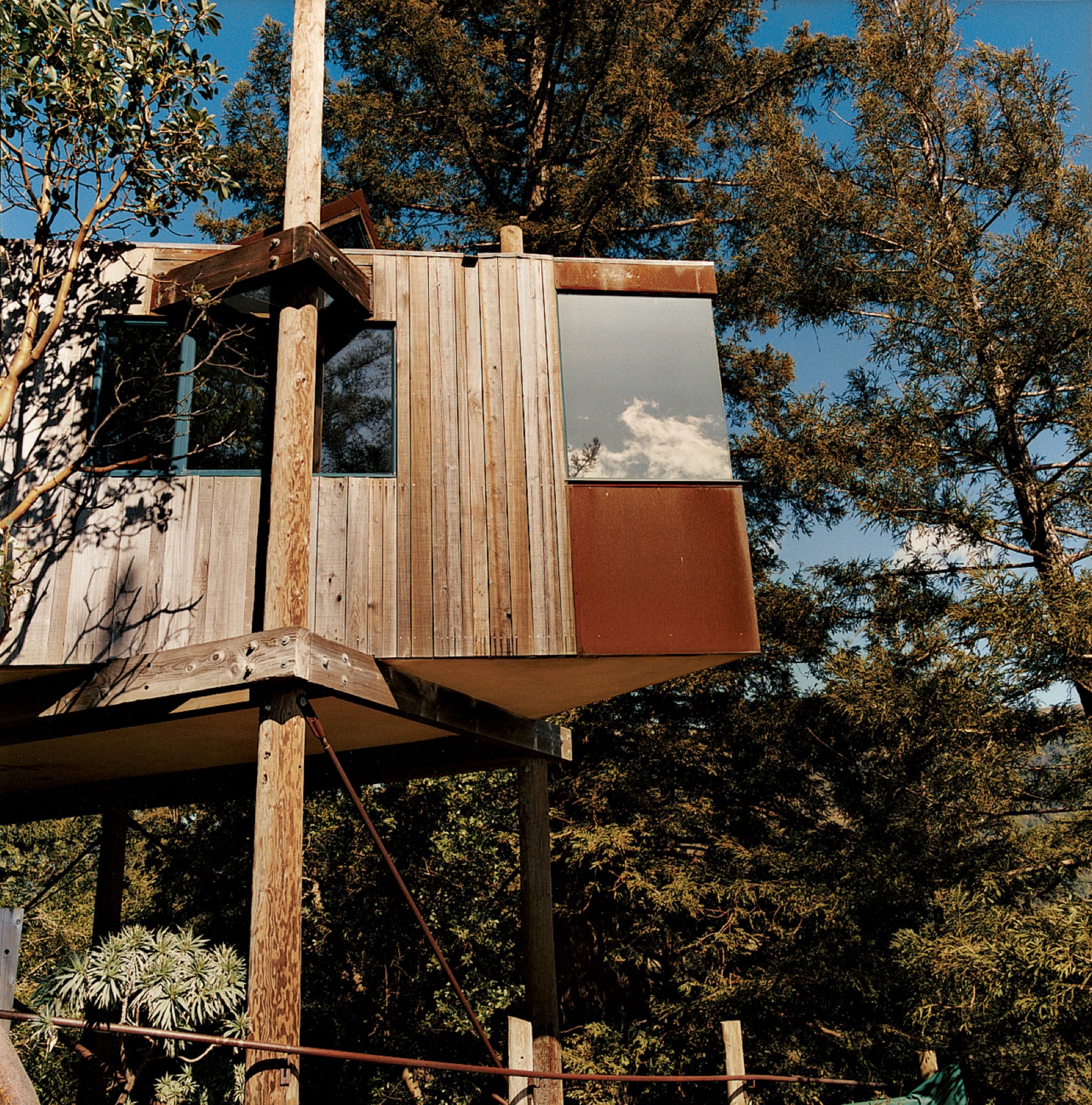
Designed by acclaimed Big Sur architect Mickey Muennig, The Post Ranch Inn consists of a series of freestanding units that showcase Muennig's contemporary organic vision. The tree houses feature Corten panels.
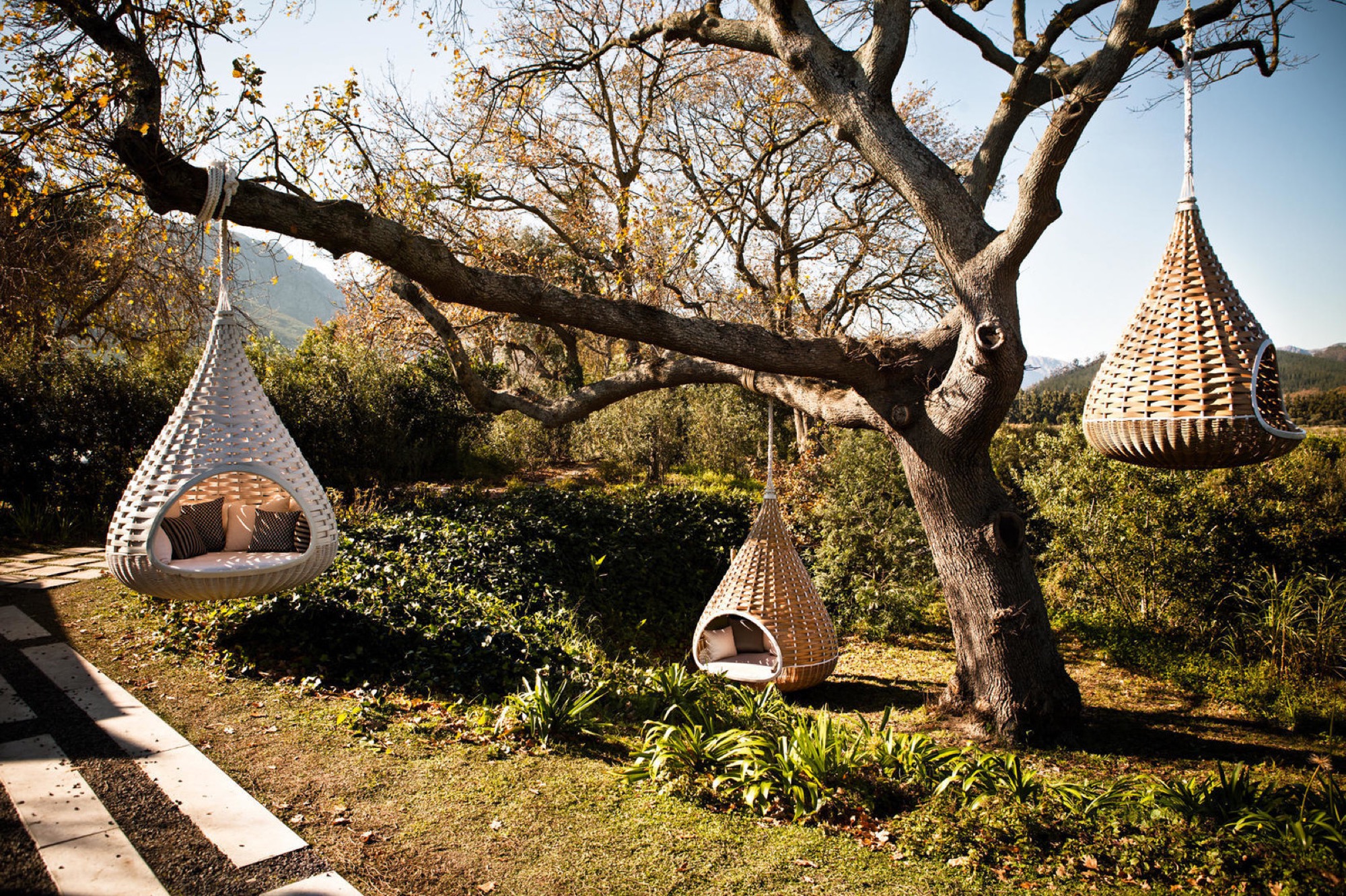
Dedon’s Hanging Lounger, designed by Daniel Pouzet and Fred Frety, can be an instant mini-tree house escape. All you need is the right tree to hang it from.
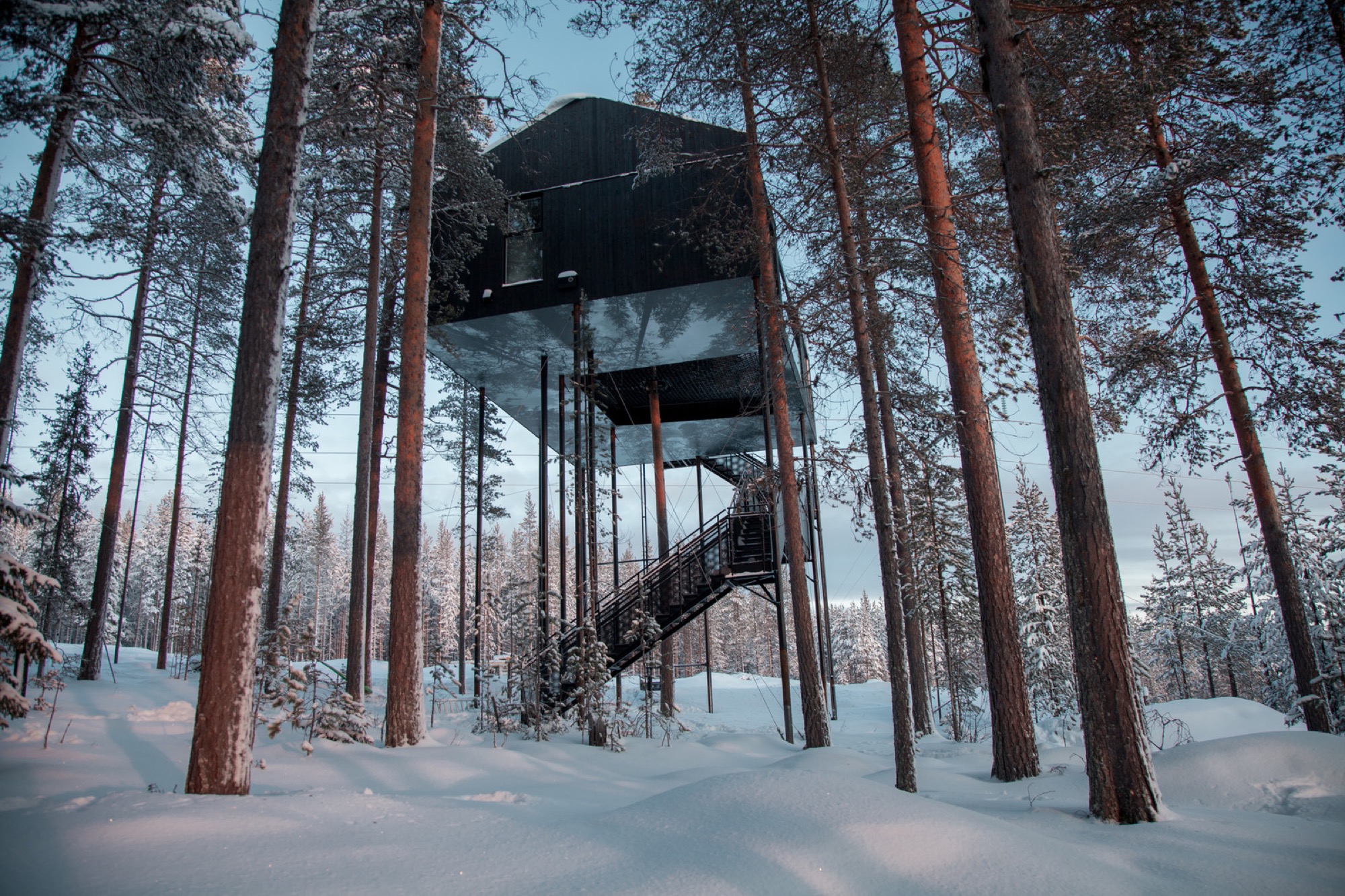
Treehotel’s 7th room in Sweden is a cabin that’s propped up in a pine canopy where guests can book a stay. To reduce the load of the trees and minimize the building's impact on the forest, 12 columns support the cabin. One tree stretches up through the net, emphasizing the connection to the outdoors.

Japanese architect Takashi Kobayashi of the Tree House People has been declared a "tree house master" by Design Made in Japan. Seamlessly integrating nature and design, this tiny tree house is certainly not just for children.

Inspired by the principle of biomimicry, Free Spirit Spheres’ goal is to "create new ways of living that are well-adapted to life on earth over the long haul." Based outside of Vancouver, the company specializes in tiny spherical tree houses that are works of art. You can even book an escape to spend the night in one at their forest hotels!
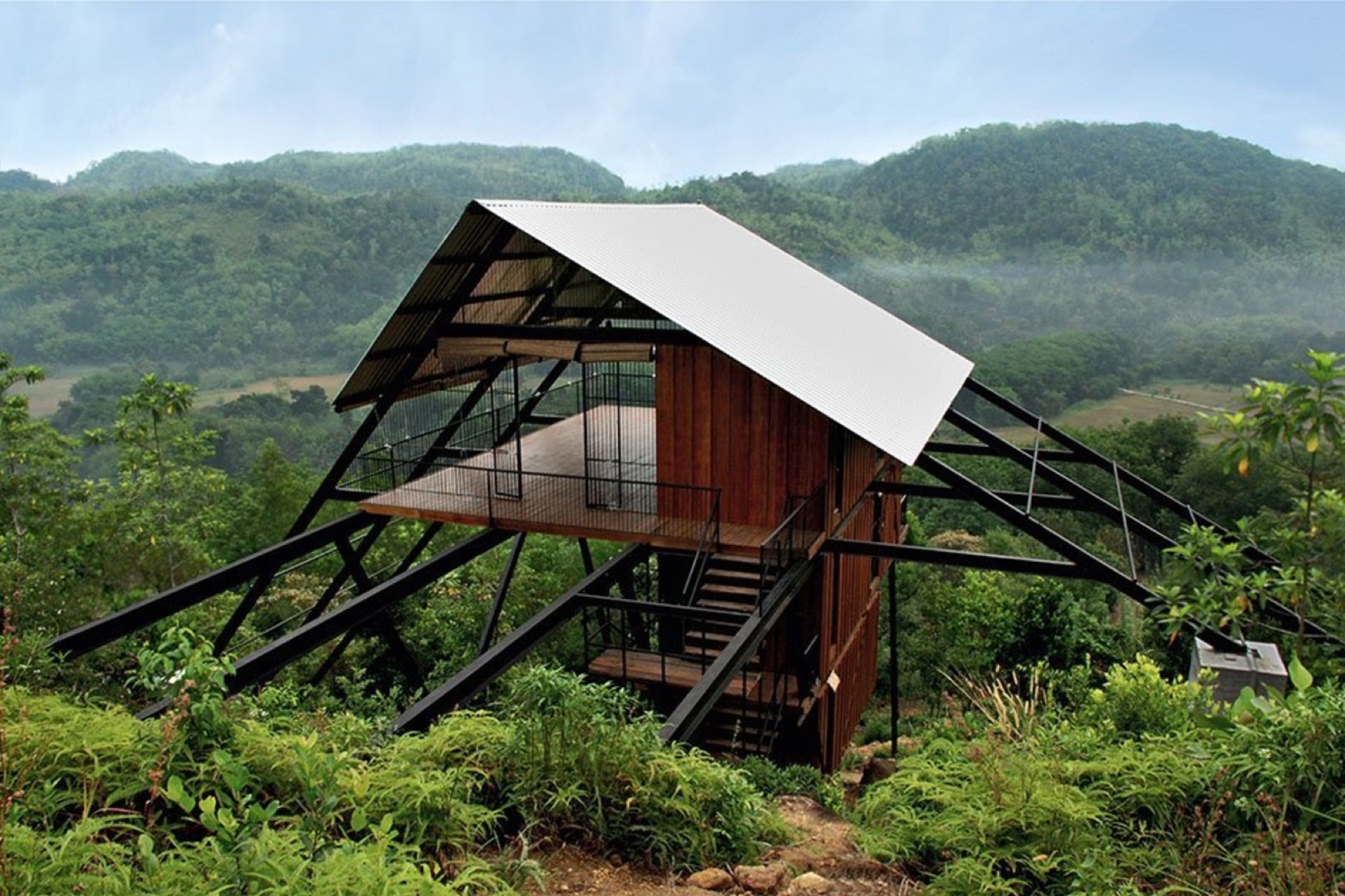
With the view from the Estate Bungalow in Matugama, Sri Lanka—designed by Narein Perara—you might just climb in and never want to leave.
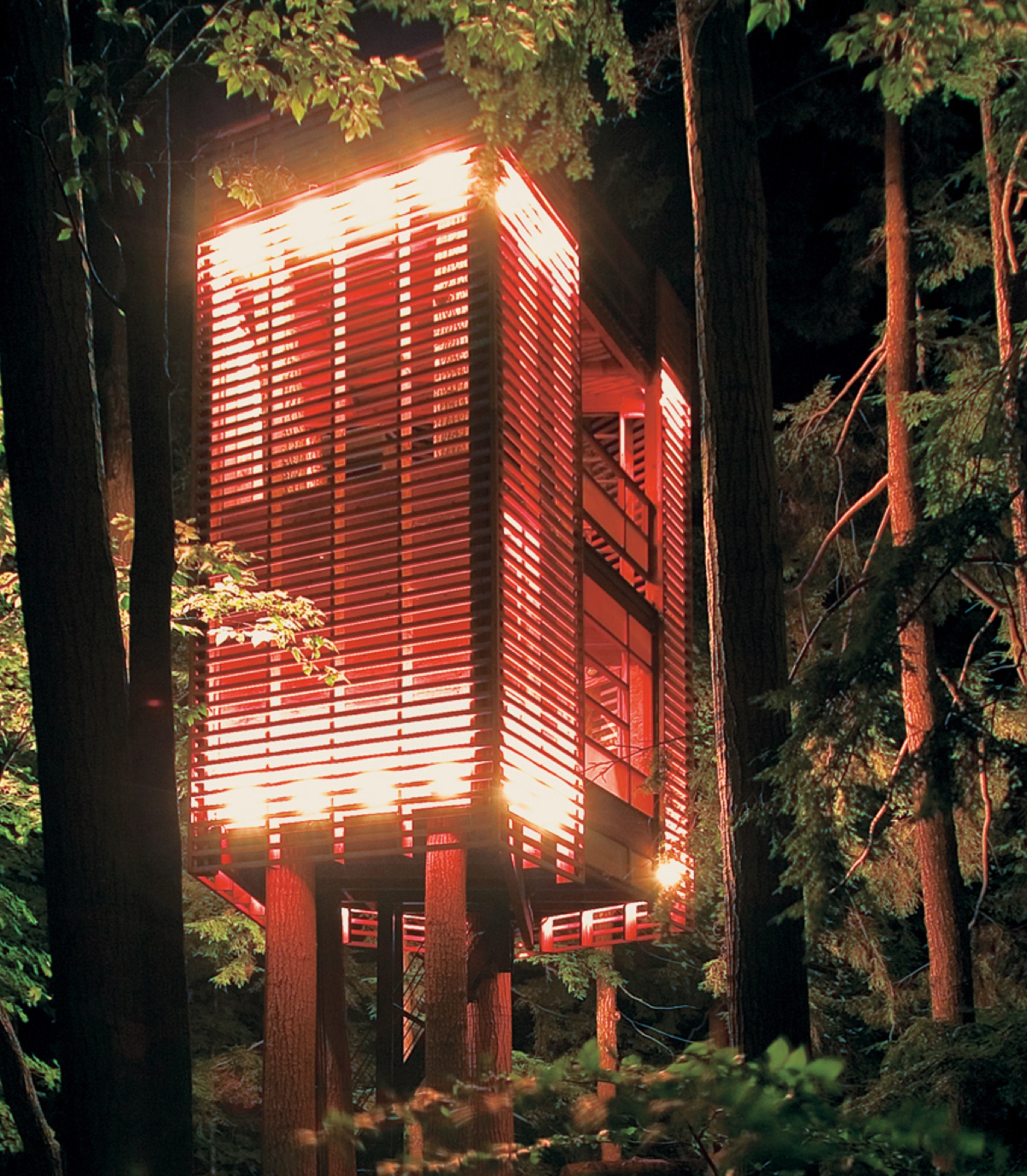
"I had to let the trees decide how the tree house would be," explains Lukasz Kos, a Toronto-based designer and cofounder of the architecture firm Testroom. The low-impact 4Treehouse is a lattice-frame structure that respects and responds to the nature surrounding it, appearing to levitate above the forest floor of Lake Muskoka, Ontario.

At only 172 square feet, this tiny tree house in the hills of Brentwood, California, was designed by Rockefeller Partners Architects and serves as a refuge, gallery, and guest cottage.

A little more on the traditional side, this tiny backyard tree house by Sticks and Bricks makes you want to disappear for a few hours with a pot of tea and a good book.
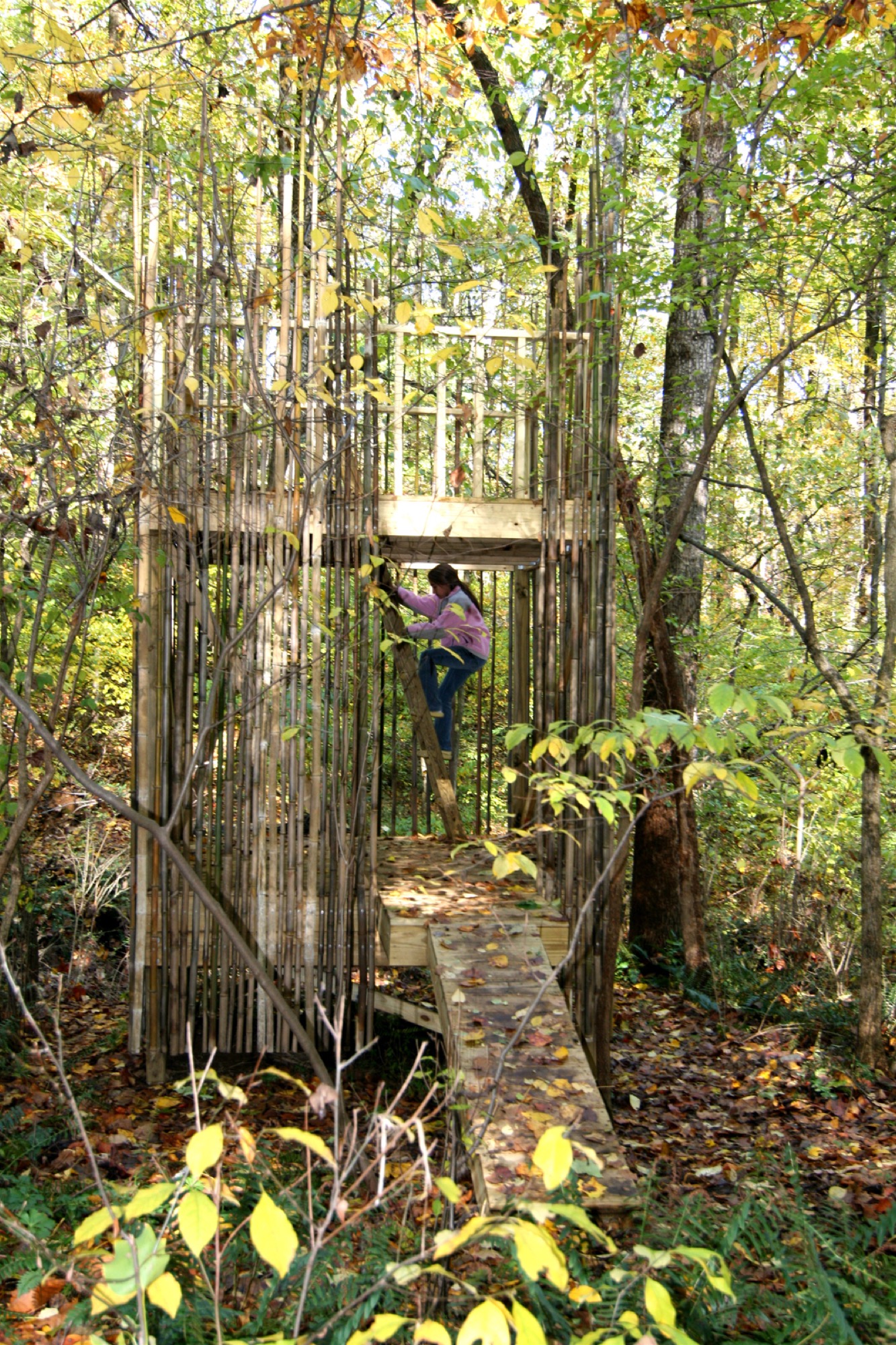
This 128-square-foot tree house outside Baltimore was designed by architects Laurie Stubb and her husband Peter. "The outdoors here are a big playground," she says. "We had always wanted to build something for the girls that looked natural." So, in the summer of 2008, they designed this structure both for the children and for themselves. "We wanted it to have a use after they're gone—a place we can sit in and read or have a drink and entertain company." △
Drop Coffee at Alpine Modern
We debut our new monthly guest roasters program with a revered household name from Sweden
At Alpine Modern, in our effort to give our community access to high-quality and interesting coffees, we have begun a monthly guest roaster program. While still consistently serving single-origin and blend offerings from MiddleState Coffee on espresso and drip, we will bring in a new roaster each month to offer variety to our customers in our batch brew coffee. We will also be selling whole bean packages of the coffees.
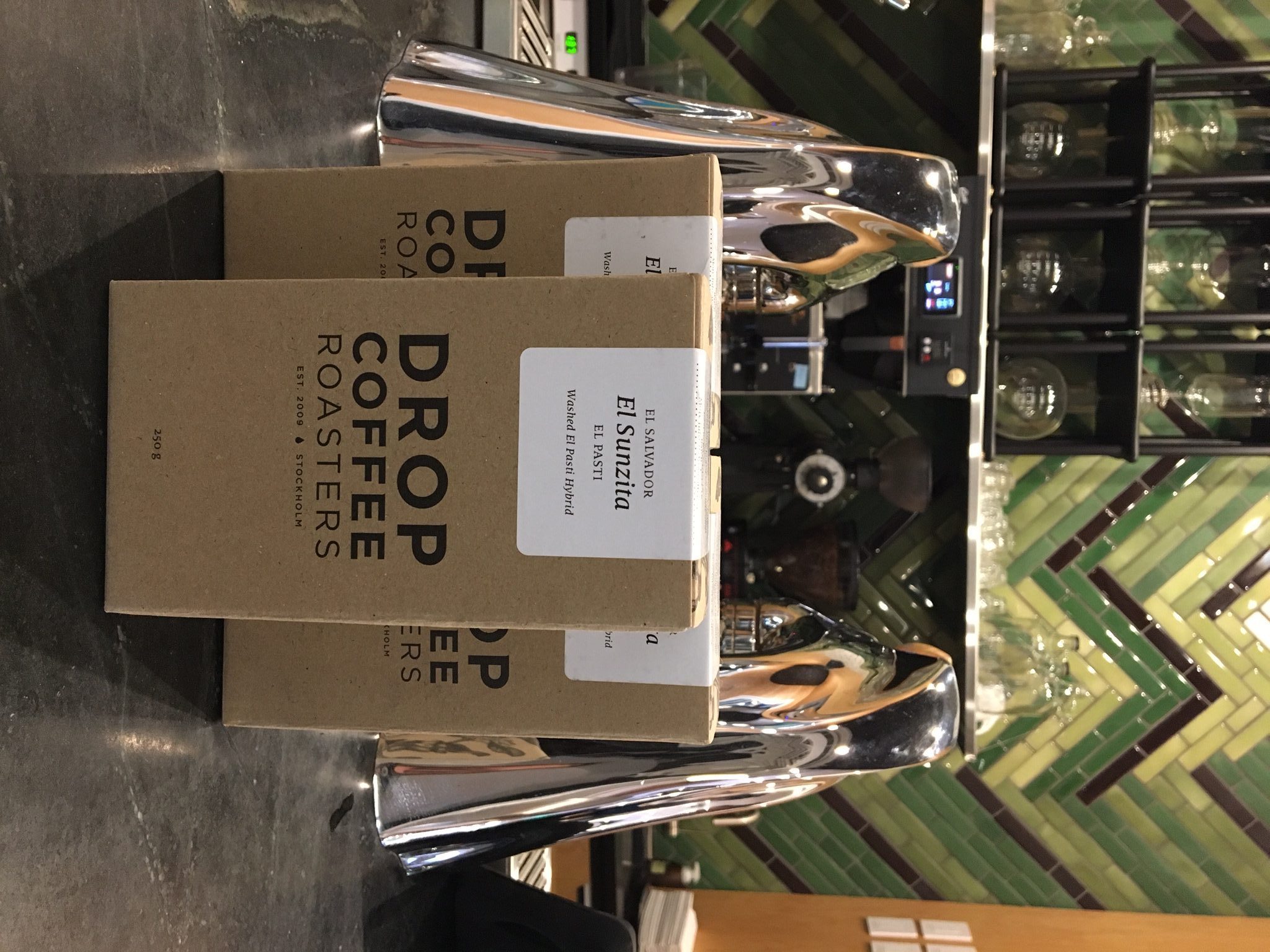
Stockholm’s Drop Coffee
We debut with Drop Coffee as a unique opportunity to taste an extremely high-quality and long-sought-after roaster and bean.
For coffee aficionados, the Swedish roaster Drop Coffee has been a revered household name. The chance to visit the famous roaster and take classes in Stockholm is considered a sort of pilgrimage for the dedicated barista.
The company started in 2009 and quickly became a leader in the specialty coffee world. Using a direct trade model, the roaster mainly sources from Bolivia, Colombia, El Salvador, Honduras, Ethiopia, and Kenya. For several years, Drop has won Sweden’s Roasting Championship and has placed in the top five at the World Roasting Championship since 2014. Sourcing from green-coffee importer Nordic Approach, started by the well-known Morton Wennergaard and Tim Wendelboe, Drop receives some of the highest-rated varietals currently in production.
In an interview with Kinfolk, Joanna Alm, co-owner and head roaster, outlined Drop’s coffee philosophy:
“We strive to bring out all the good natural flavors of the coffee in the roasting process without adding any roast tones. It’s crucial for us to keep all the natural flavor of the coffee throughout each step of the production chain, from the cherry to the final cup, regardless of the brew method. This is a bit controversial on the coffee market, but it’s the only way to achieve our aim to get most out of the product.”
"It’s crucial for us to keep all the natural flavor of the coffee throughout each step of the production chain, from the cherry to the final cup, regardless of the brew method."
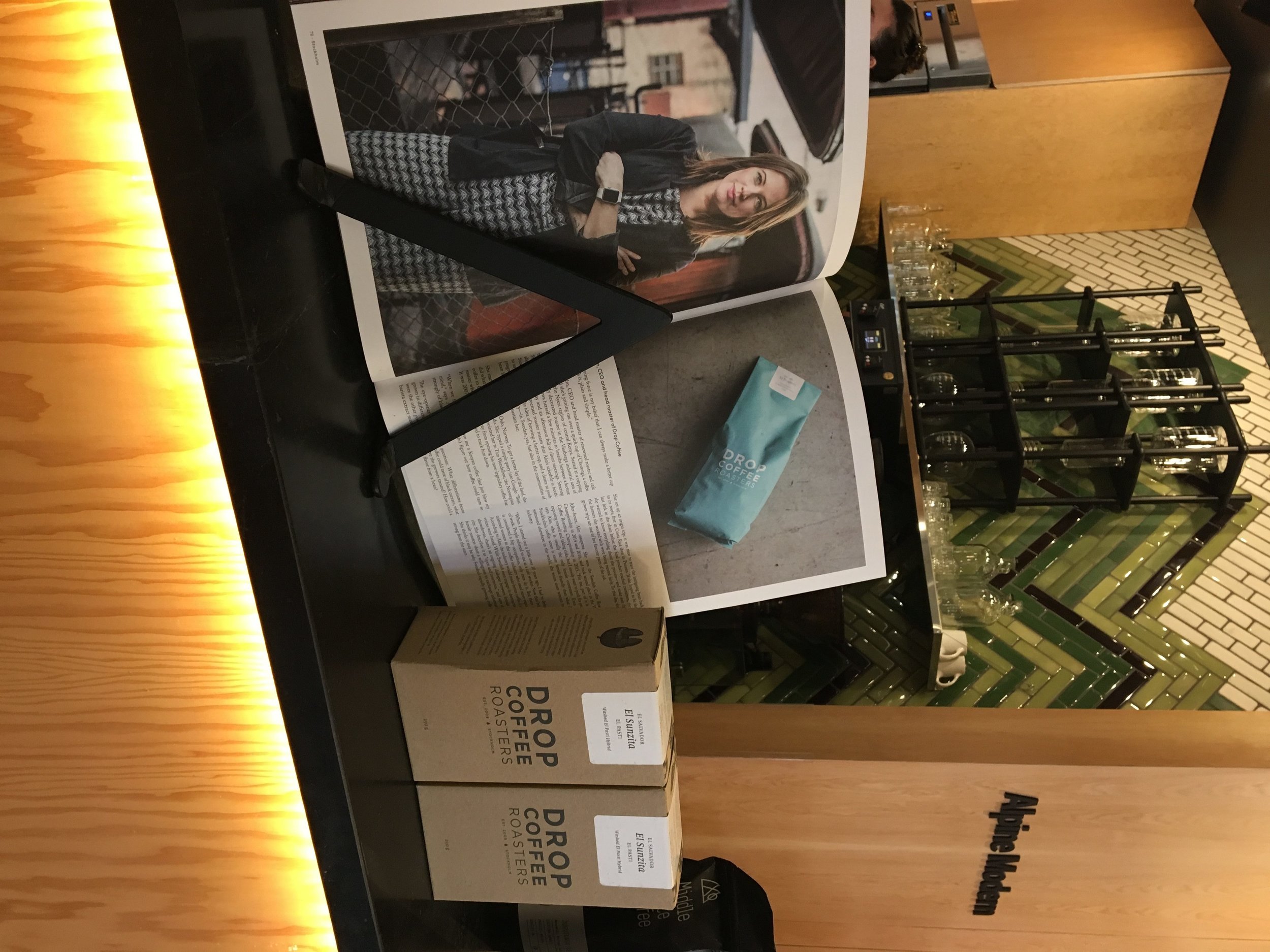
The Coffee: El Sunset
The coffee, El Sunzita from El Salvador, is a Bourbon hybrid called “hybrid El Pasti” that comes from the farm of Mauricio and Mary Ortiz in the growing region of El Pasti.
Joanna Alm writes on the Drop Coffee website:
”El Sunzita is a great example of driven producers who are putting in the extra work to higher the quality Mauricio Ortiz and Mary Ortiz are looking at their microclimate and trying to work the most organic they can in an area suffering hard from leafrust. The location of the farm and the view is something else and one of the most beautiful farms I’ve visited.”
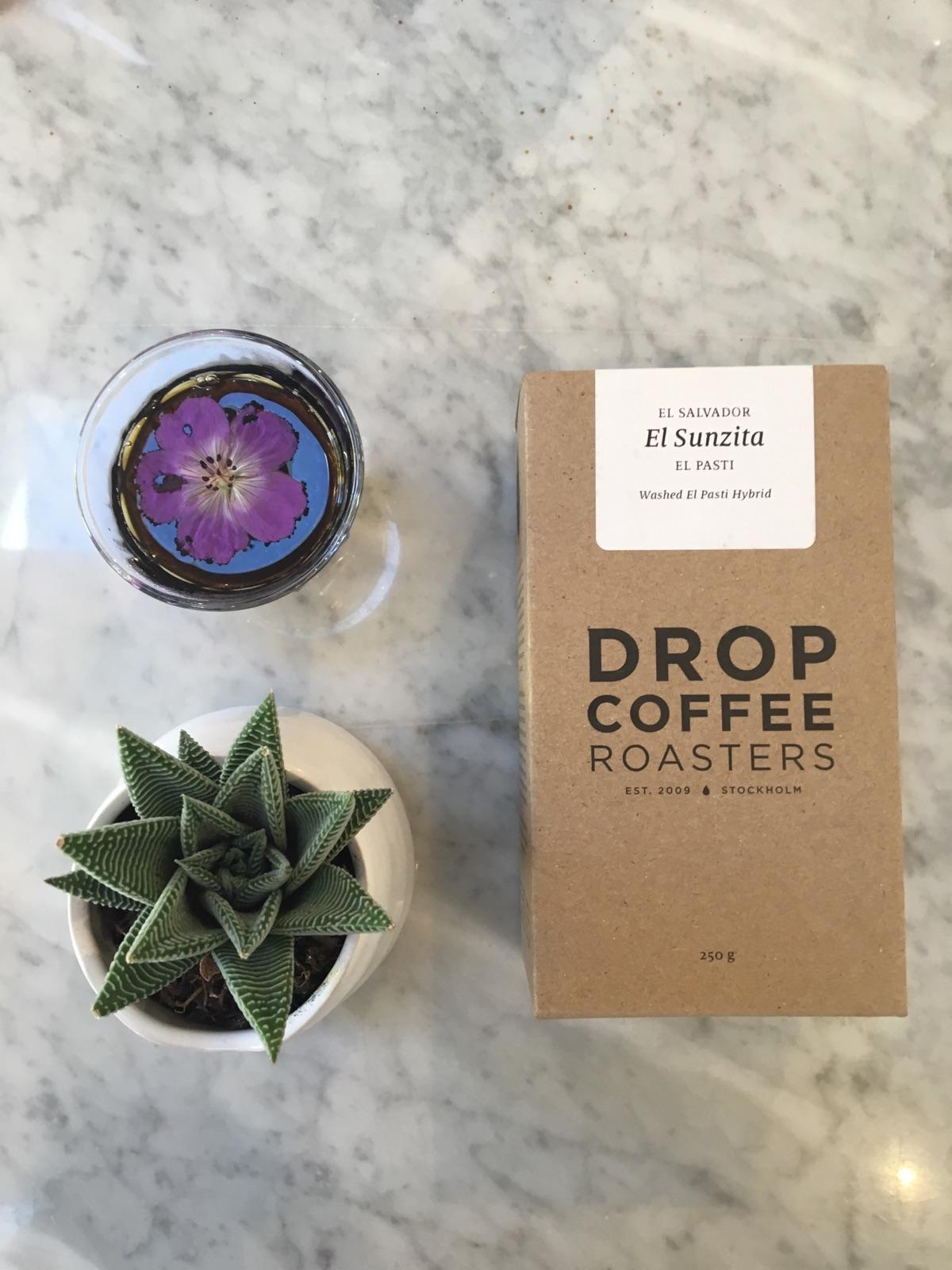
“Bourbon” is a coffee varietal that was brought from the Indian Ocean island of Bourbon (Reunion) in the early nineteenth century and was transplanted in Brazil, Central and South America, and Rwanda. It soon grew popular because of its ability to produce quickly and efficiently. El Salvador, in particular, is known for the varietal that offers toffee and caramelized notes. The Ortiz’s Sunzita is a special hybrid of the Bourbon varietal and makes up about 65% of the farm that sits in Santa Ana at 4,000 feet (ca. 1220 meters).
The coffee is fully washed; meaning all the pulp surrounding the bean is cleared away, leaving a clean, bright cup of coffee with very little inconsistencies. El Sunzita has a medium body with notes of raisin, chocolate, and dark cherries.
The high quality of the bean is mirrored in the sleekness of the packaging design. 250 grams are sealed in an airtight plastic re-sealable package and placed inside a small tan box that features an intricate line-work drawing of a coffee cherry and plant. Alpine Modern is selling these limited edition packages for $20 each.
For the rest of October, come by the Alpine Modern Café at 9th and College in Boulder or our new Alpine Modern Shop + Coffee Bar at Pearl West to sample El Sunzita on our Curtis batch brewers or take home a bag of this sought-after coffee. △
She Felt Beautiful
Swedish designer Pia Wallén talks about her iconic Crux Blanket and the bold creations she makes from wool felt
Pia Wallén, who was born in Umeå, Sweden, and now lives and works in Stockholm, creates bold, minimalist objects from her signature wool-felted materials.

Wallén, who studied fashion design at the Beckman’s College of Design in Stockholm in the mid eighties, made an international breakthrough with her own namesake brand in the early nineties. Over the years, she has collaborated with IKEA and brands such as the Swedish design label Asplund and Italian leather manufacturers Arte & Cuoio.
Inspired by traditional Swedish folk craft techniques and patterns, her bold, minimalist designs also have a dramatic modern edge. This juxtaposition of ancestral craftsmanship and her unmistakeable, contemporary—yes, futuristic—designs have become Wallén’s trademark.

Her already iconic work is displayed in the permanent collections of Sweden’s National Museum of Fine Arts, the Röhsska Museum for Design, Fashion and Decorative Arts in Gothenburg, and the Museum für Angewandte Kunst in Cologne, Germany. She has participated in exhibitions around the globe, including at the Centre Pompidou in Paris and Victoria & Albert in London.
One our favorite Pia Wallén designs at Alpine Modern is the Crux Blanket, which the designer designates her “icon.” In Swedish folk art tradition, the cross (crux in Latin) is a strong symbol for hope, a meeting point of heaven and earth, plus, the designer says German artist Joseph Beuys (1921–1986) was also an influence. Introduced in 1991, the Crux Blanket has meanwhile become a classic in contemporary Swedish design history. Fostering mutually meaningful and lasting relationships with her manufacturers is very important to Pia Wallén. The original blanket is still produced by the same small family weavers in southern Sweden, using the finest wool and traditional Scandinavian felting methods.
The traditional weaving and felting process takes time, which is why supply of the handcrafted wool object is limited. Thus, Pia Wallén has introduced a new version of her treasured paragon: the new Cross Blanket in pure organic cotton, produced in collaboration with a Swedish company that manufactures in Peru.
We recently caught up with the designer to talk about her brand, her inspirations, and about life.
A conversation with Swedish designer Pia Wallén

What is your vision for the brand that bears your name?
My ambition is to create a deeper meaning, content, sympathy, and respect in the relation between the object and the user.
Your collections include accessories, jewelry, and interior objects. How do you decide what products to make?
It’s a combination of fulfilling my personal needs, ideas, and a curiosity for developing my new products as well as my old ones. It’s a lot like researching. It’s important for me to find and develop a good relationship with my manufacturers, and together with them create new techniques and products.
Your recent lines of accessories and jewellery have joined objects that combine felt, metal, leather, lacquer, plastic, and other materials in striking new ways. How do you choose and source your exquisite materials?
I’ve specialised in wool-felted materials and that is the main material throughout my collections. I’m inspired by materials from different cultures as well as by new, futuristic materials.

What does quiet design mean to you?
Quiet design is discrete and anonymous.
What’s your legacy (thus far)?
That my designs are objects to like, to sympathize and share a life with. My classic objects, like the Slippers and the Crux Blanket, have been in the collection for over 20 years, and I hope for many years to come.
What’s your favorite place in the world?
Paris, it’s like a second home for me.
What does “home” mean to you?
Home is where I nourish.
What’s most important to you in life?
Love and health.
When are you happiest?
When I exceed the expectation of my creations.
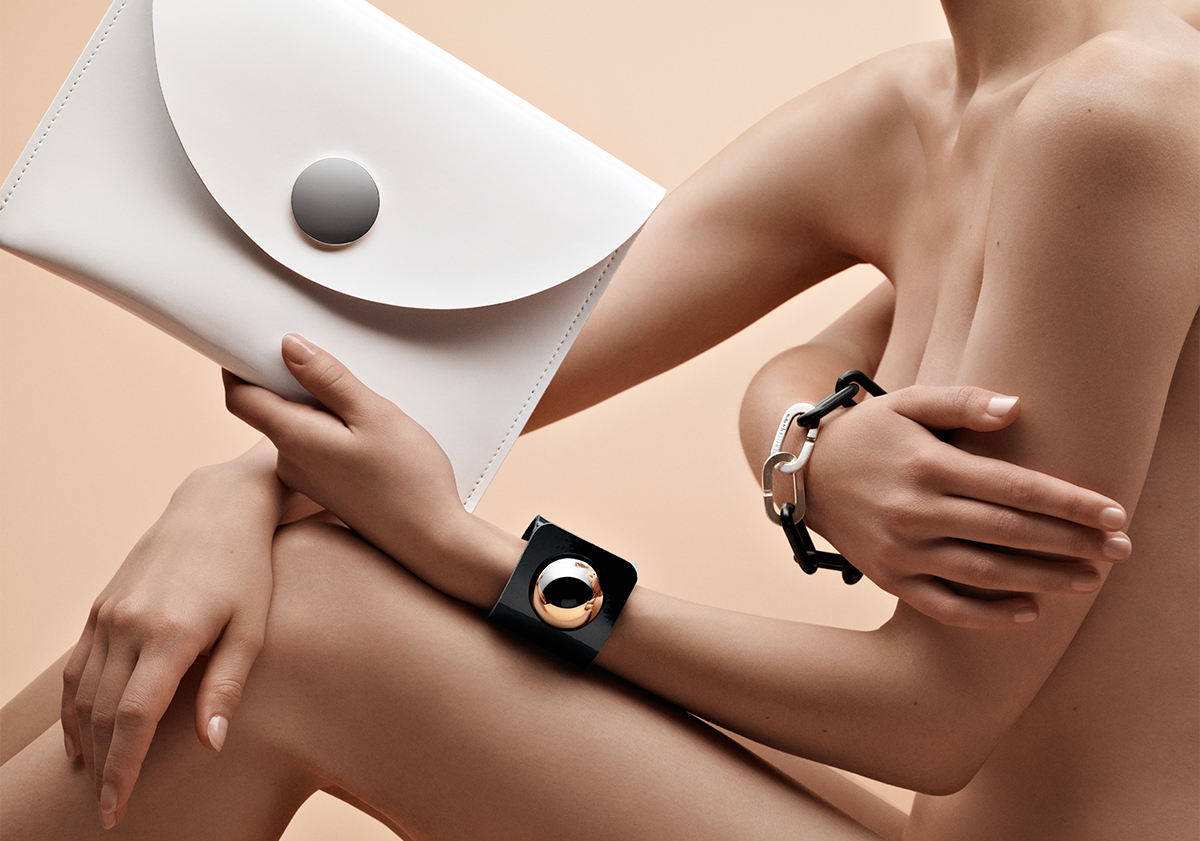
Who is your design icon, and what do you admire about her or him?
The artist Eva Hesse, for her work and life—a pioneer for female art. And also the artist Meret Oppenheim; she has influenced some of my work.
What are you working on these days?
Currently, I am working with the exhibition “Shapes of Fashion—Nordic Artwear” for the Textile Museum in the south of Sweden. It’s a continued work of my Capes Project, which started in 2015. △
The Tippy Brass Ballerina
A conversation with designer Eero Koivisto of Claesson Koivisto Rune about the accidental making of the dancing brass bowls
Ballerina is a series of unstable bowls in a highly polished brass plate, designed by the Swedish design studio Claesson Koivisto Rune and produced by the 400-year old metal manufacturer Skultuna, one of the oldest companies in the world.
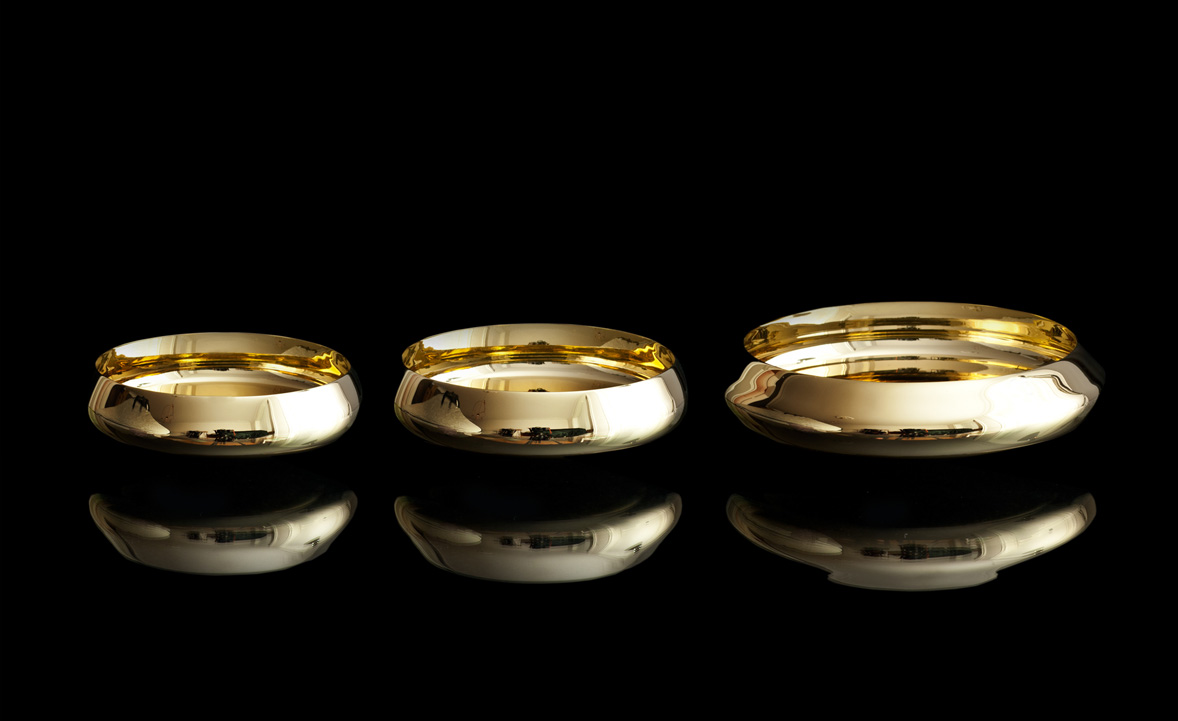
Skultuna, was founded in 1607 by King Karl IX of Sweden as a brass foundry and is still a purveyor to the Royal Court of Sweden, still in the same location. Today, Skultuna works with international designers, including the Swedish architectural partnership Claesson Koivisto Rune, founded 1995 in Stockholm by Mårten Claesson, Eero Koivisto, and Ola Rune. The firm meanwhile puts equal emphasis on architecture and the design of objects from tableware, textiles, and tiles to furniture and lighting.

One of our favorite Claesson Koivisto Rune designs are the tippy brass Ballerina bowls, manufactured by Skultuna. When looking into a bowl, the polished concave inside distorts the reflection so that the actual shape appears flat. Their convex bottoms make the bowls rock and dance when touched. When in movement, the Ballerina bowls also project “dancing” golden, glimmering light reflections around the room. We spoke with the bowls' modernist creator and co-owner of Claesson Koivisto Rune.
A conversation with architect and designer Eero Koivisto

Above, from left: Mårten Claesson, Eero Koivisto, and Ola Rune, the three founders and eponyms of Claesson Koivisto Rune Architects
What is the story behind the Ballerina bowls?
Actually, the bowls started with another product brief for Skultuna, which sort of transformed into the Ballerina bowls. What was the downside of the original design—the movement—turned into a design feature when we decided to make them into small bowls.
One can't help but touch the elegant, shiny bowls and rock them. What is the significance of their intentional movement?
We have worked with movement in usually static design objects before—for example PEBBLES seating for Cappellini, SEESAW for DeVecci, and BASSO, MOEBIUS, and BELLE, also for Skultuna. Since the bowls are fairly small, the movement comes across as playful and slightly surprising.
"Since the bowls are fairly small, the movement comes across as playful and slightly surprising."

When you hold a Ballerina bowl in your hands today—your design that came to live through craftsmanship—what goes through your mind... and heart?
What started out as an idea about movement, has turned into a quite beautiful object in itself.
You designed these bowls for Skultuna. In what way is the experience of designing for a more than 400-year-old company unique?
The owner and the CEO are fairly young, so even if there’s a lot of history involved, they are a pretty youthful company and always open to new ideas in design.
Thus far, what’s your legacy in the design world?
I’m very honoured to be asked the question regarding our work, but I wish to pass it on to others, who can see beyond our own studio, to answer it.
What makes you a modernist?
Living in a modernist society.
What does "quiet design” mean to you?
We are very attracted to the idea that objects co-exist in a given context. Our work is not brash or loud, and it functions well together with other things, which can be totally different in their approach. We don’t really like ”look-at-me” objects.
"Our work is not brash or loud... We don’t really like 'look-at-me' objects."
Usually there’s a lot of idea work in a particular design that is only obvious if you know the story behind it. But when you know the idea behind a certain object we have designed, a new depth occurs—kind of intellectual, but not in an excluding way.
On the other hand, we like the idea that you can use our designs for a lifetime without getting bored by them and without having any idea whatsoever why they look, feel, and function a certain way.
"We like the idea that you can use our designs for a lifetime without getting bored by them and without having any idea whatsoever why they look, feel, and function a certain way."
You design accessories for the home. What does “home” mean to you?
Most of our work is buildings, since we are an architectural studio, but we enjoy doing smaller objects and furniture, too. If architecture is our life’s journey, the smaller objects are the nice dinners with friends along the way. So, home is where we live our lives. Wherever that may be.
"If architecture is our life’s journey, the smaller objects are the nice dinners with friends along the way."
What’s most important to you in life?
My family and my work. In that order.
When are you happiest?
At home and at work. In the same order.
Who is your design icon?
I don’t really have icons anymore, but I do admire good work from people I know.
What inspires you as a designer?
Art and music.
What are you working on these days?
About ten different architectural projects—private houses, places for art, apartment buildings, hotels, and about 40 design projects in various stages of their design. All over the globe. △
Naked Naust
A dramatic cabin by Swedish architect Erik Kolman Janouch on Norway's wild Vega Island
Inspired by Norway’s traditional boathouses, Swedish architect Erik Kolman Janouch plants a cottage into Vega Island’s barren landscape—its design so minimal, it becomes dramatic.

“It’s basically just two ordinary pitched roofs,” architect Erik Kolman Janouch describes the Vega Cottage on the namesake Norwegian island. But the simple elegance of this small wooden cottage that blends so perfectly with its wild and forbidding landscape is, in itself, spectacular—not to mention the boldness and care in siting it there. What’s more, it is exactly what could be expected in this coastal region of Norway.
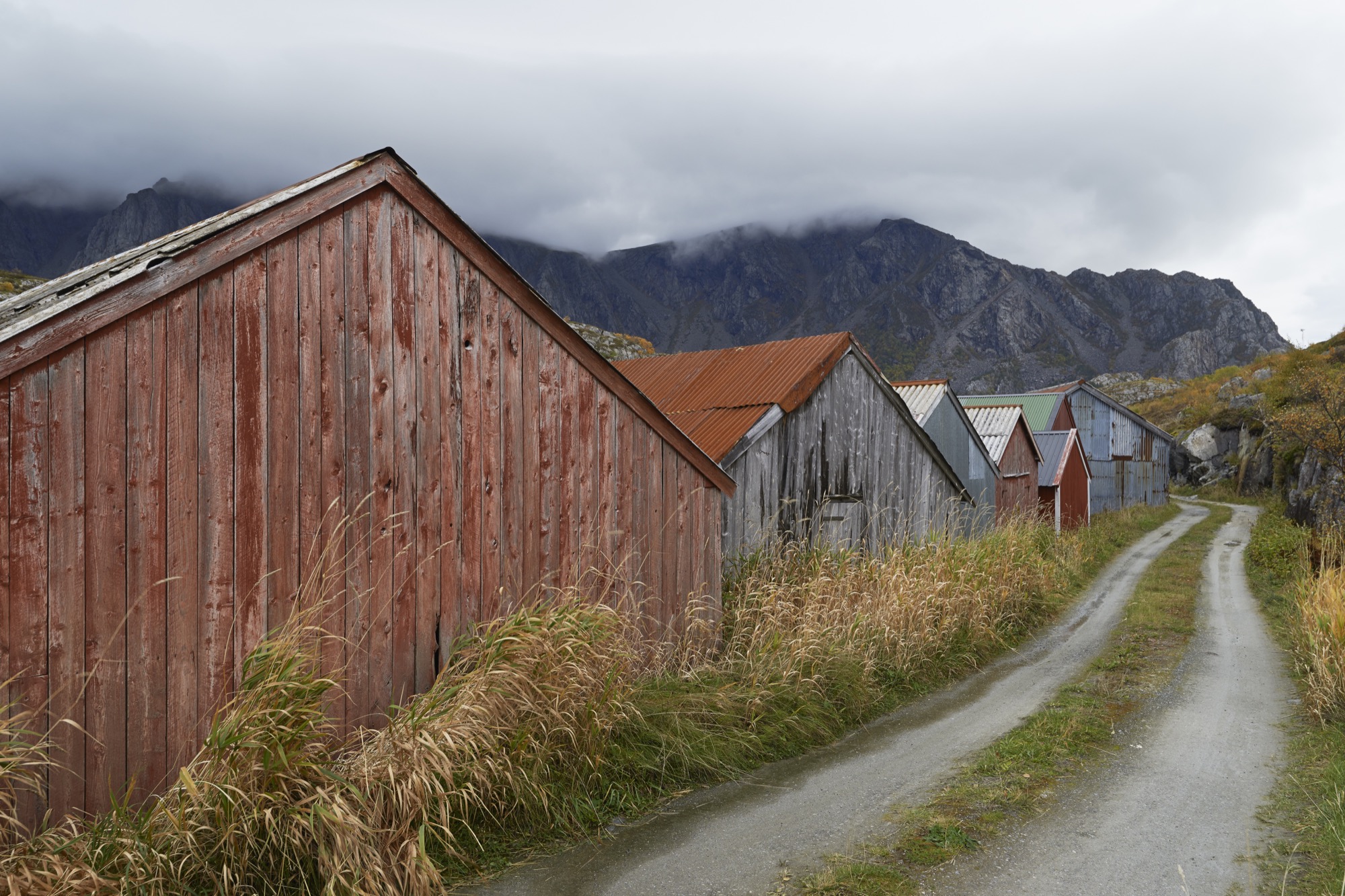
Not far from the house, by the seashore, stand a few of the colorful traditional boathouses—naust—found throughout Norway’s long Atlantic coast. With origins in the Viking era, this building type has withstood the test of time and weather with the island’s extremely rough climate. So, looking for another architectural typology for the Vega Cottage seemed like a futile enterprise for its Swedish architect of Kolman Boye Architects in Stockholm.
Casual observers might also miss the second most striking architectural feature of the Vega Cottage—its windows. At first, the house’s windows might appear like ordinary rectangular openings in a wall, covered with glass. But that’s just scale and perspective playing tricks, since the barren landscape of Vega Island offers little else of human scale for comparison. Standing directly in front of the house—where one’s cheeks quickly turn rosy from the cold Atlantic wind—an adult visitor can stand head to toe in the huge windows and absorb the majestic landscape. Buffeted by the wind and swept away with the dramatic views, one realizes that the windows are what this house is all about. They showcase the grandeur of the island.
"The windows are what this house is all about. They showcase the grandeur of the island."
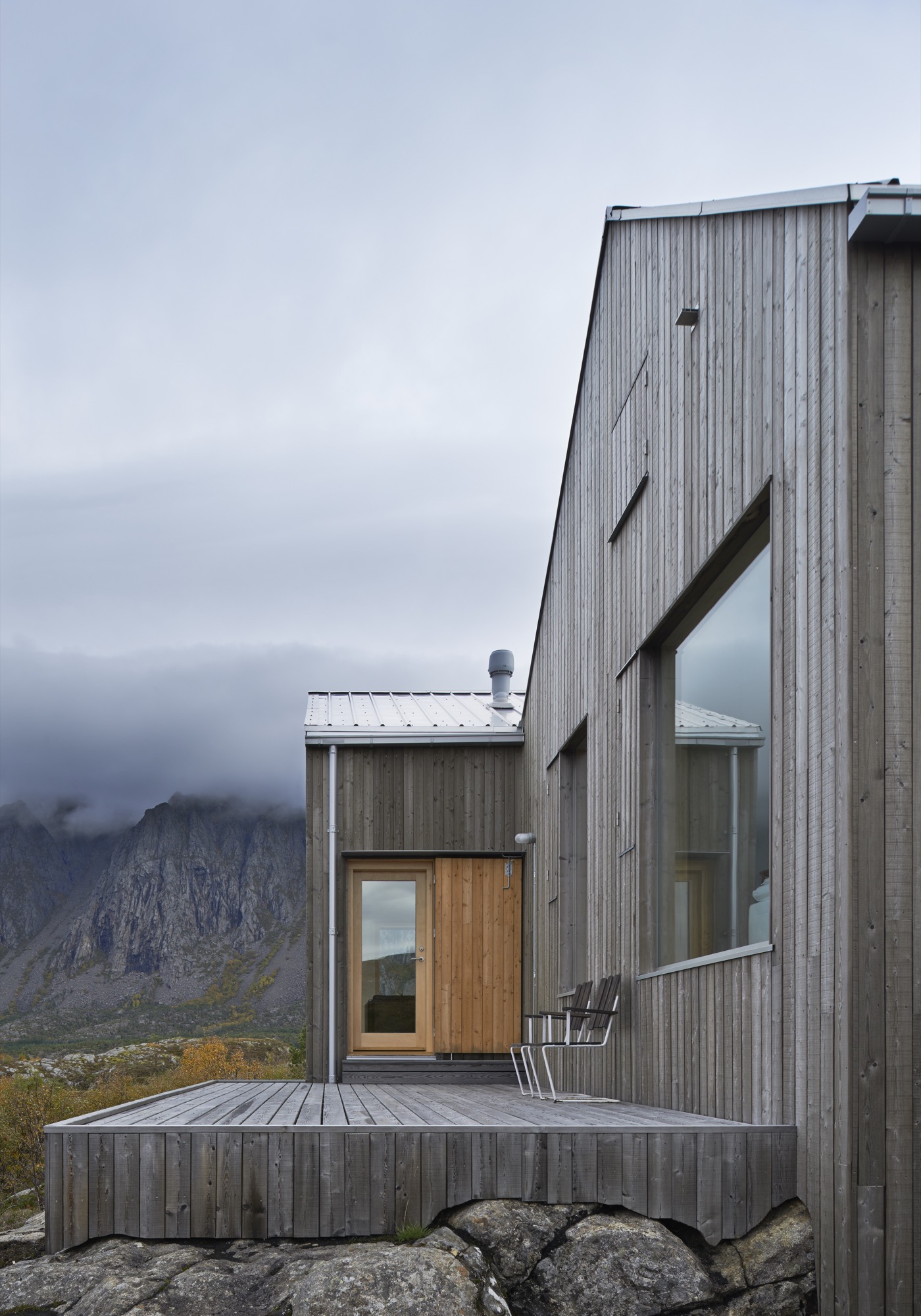
A Place Apart
Vega is home to 1,200 people and lies roughly an hour by ferry out in the Atlantic from the tiny city of Brøn- nøysund on the west coast of Norway, just south of the Arctic Circle. The cottage’s site is not much more than a farmstead, marked on the map as Eidem.
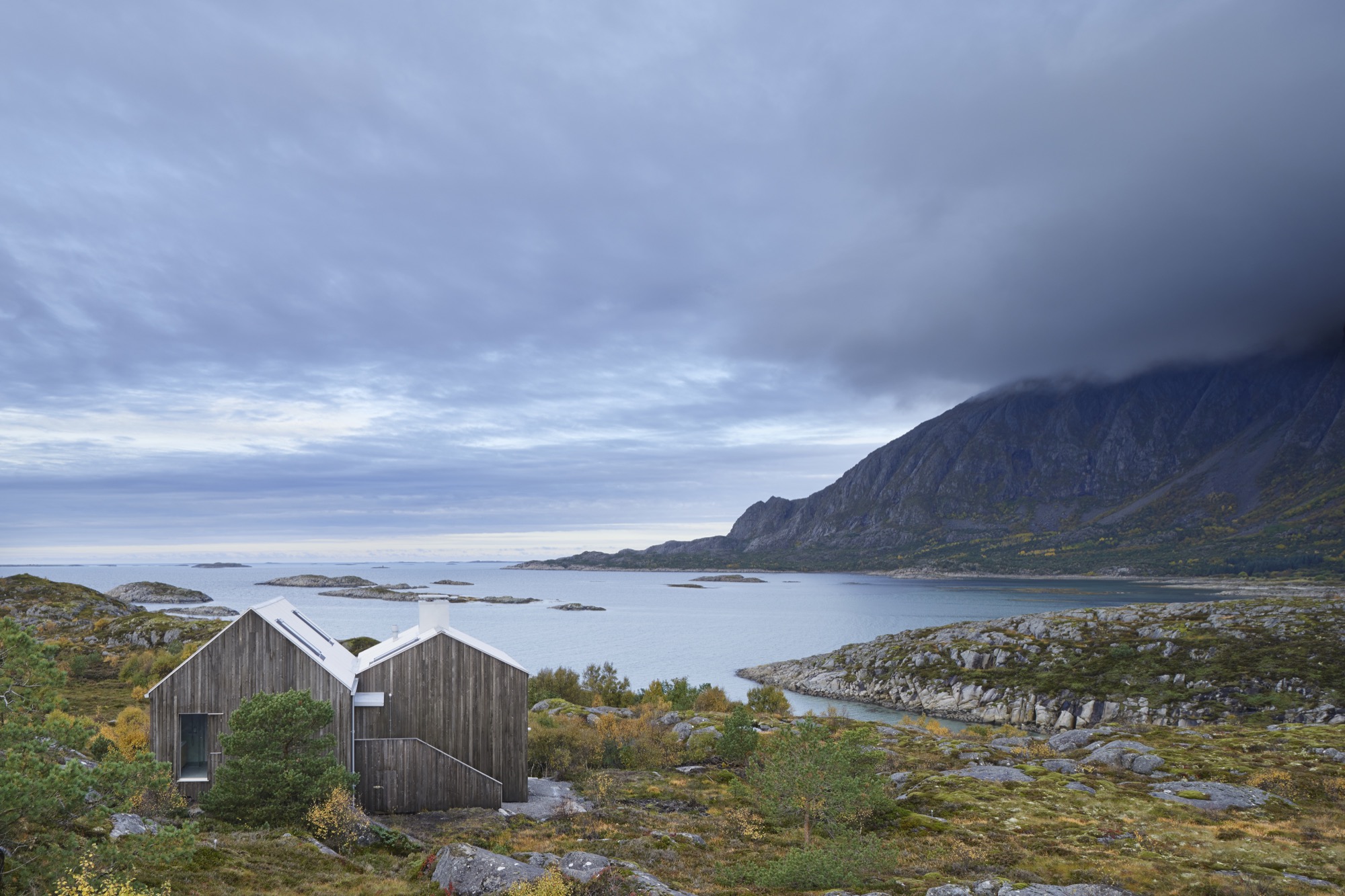
This is where the man who commissioned this house, Norwegian theatre director Alexander Mørk-Eidem, has his roots. Born on the island, he has lived most of his life on the mainland, and for the past ten years in Stockholm, Sweden. That is also where he met the architect. He approached Kolman with his idea for a country house or a cottage, commonly known in Norway as a hytte. A small and simple residence in the countryside where you go on weekends and during vacations to relax and enjoy nature... something with which Norwegians, blessed with a country of stunningly beautiful mountains and fjords, seem to be obsessed.
The end of the world, as Vega feels, seems like the obvious place for a director of the stage to seek peace and quiet and to find inspiration. Mørk-Eidem jointly owns the house with his siblings, a brother and a sister who now live in London and Oslo. The house is intended as a place for solitary retreats, but also for family gatherings, since an uncle and cousins still live on Vega.
“Inside, the house is neutrally furnished to allow for nature to...” Mørk-Eidem starts to explain when I visited the house, only to get interrupted by his architect: “It’s like three paintings. There is no need to adorn the walls.”
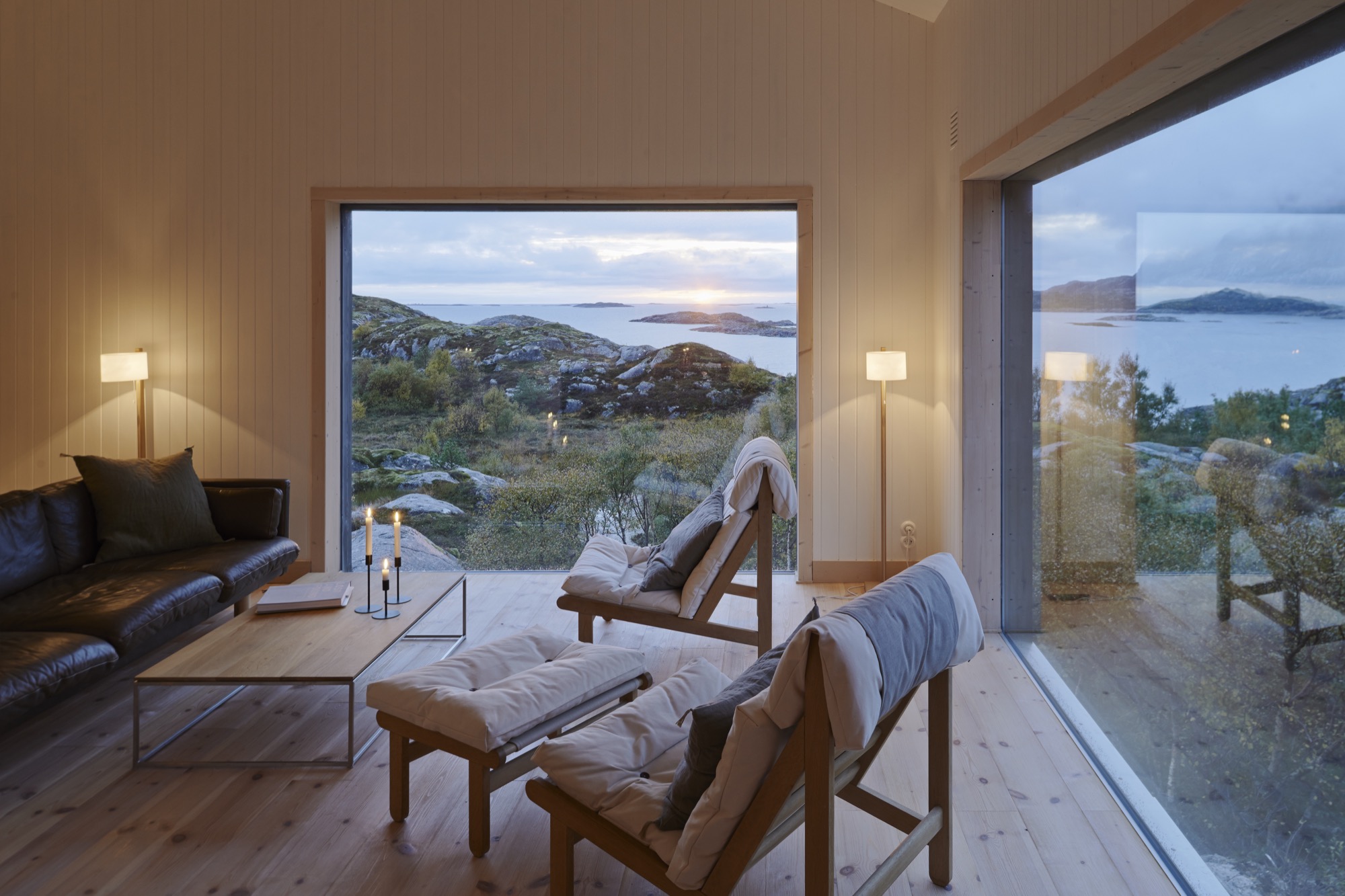
The Cast of Characters
What they mean is that the house is built to be a minor character—the lead is reserved for the surrounding landscape. It doesn’t take a stage director to reach that conclusion. Trying to cast this drama in any other way would have been pointless. On the other side of the windows of the combined living and dining room lies the mighty Trollvasstind mountain, 800 meters (2,625 feet) high with a ridge that’s hidden behind milky white clouds. In the other direction the Atlantic Ocean and open sea stretch all the way to Labrador in Canada.
“What they mean is that the house is built to be a minor character—the lead is reserved for the surrounding landscape... Trying to cast this drama in any other way would have been pointless.”
Kolman recalls the first time he came to the island and the site, after having accepted the challenge of designing the house: “I went there in January, which is the worst time of year, weatherwise. It was pitch dark and freezing. Shockingly freezing, really. I wasn’t prepared for how harsh the climate would be.”
But nature can be kind on Vega, too. At milder times of the year, when the tide comes in during the day, the sand at the shoreline that had previously been heated by the sun warms the shallow water, allowing for some appreciated beach life. But the weather changes quickly here: from calm to a wind you can lean against in a matter of minutes. It is wise never to leave the house without the proper attire: mittens, Wellingtons, and a decent raincoat.
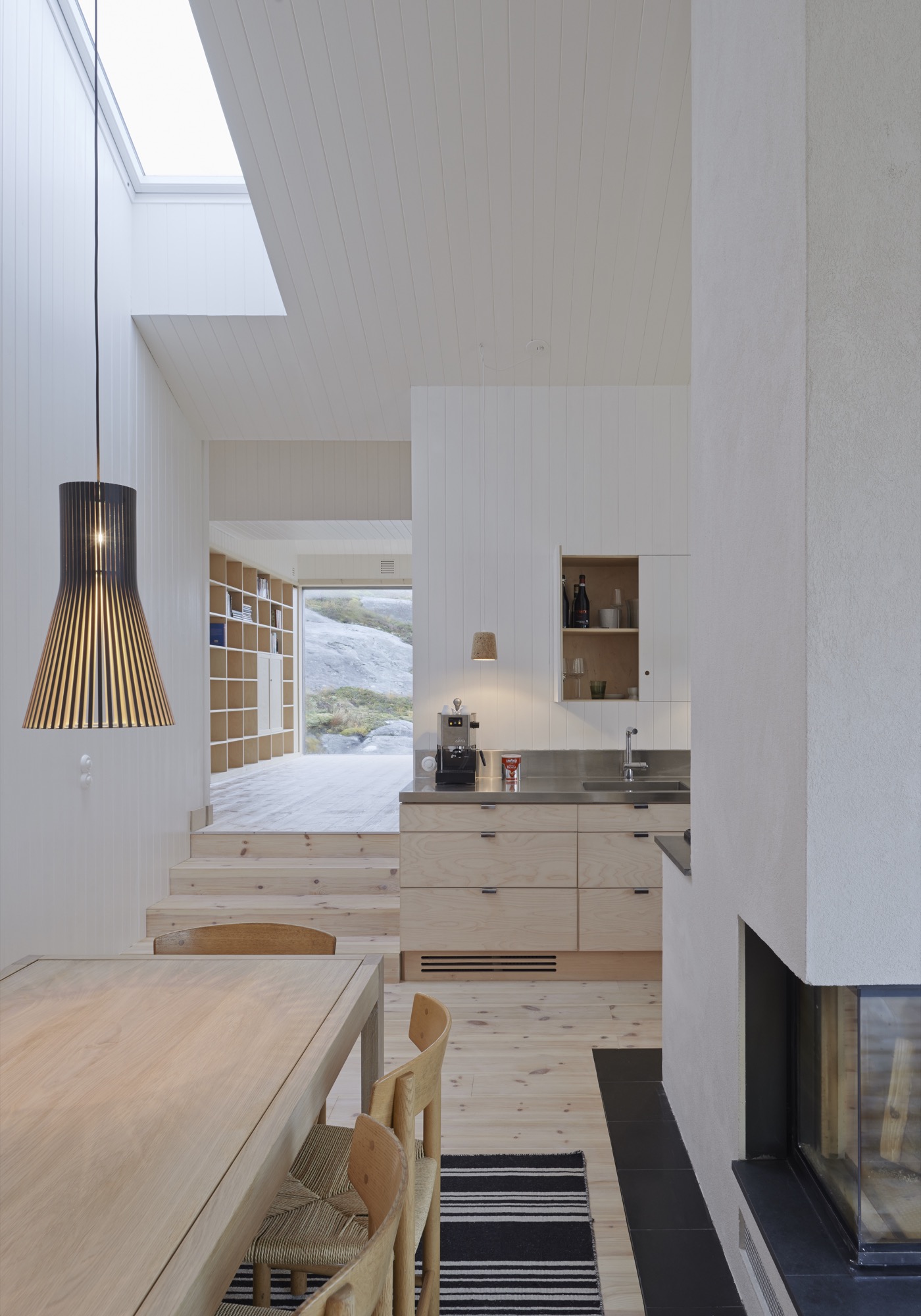
In contrast to the adventurous landscape and weather of Vega, the cottage interior is serene with a neutral color palette to enhance the tranquil atmosphere. Practically everything inside the house, from the walls to the bed linen, is white. The architect thinks it gives the house a hotel-like quality.
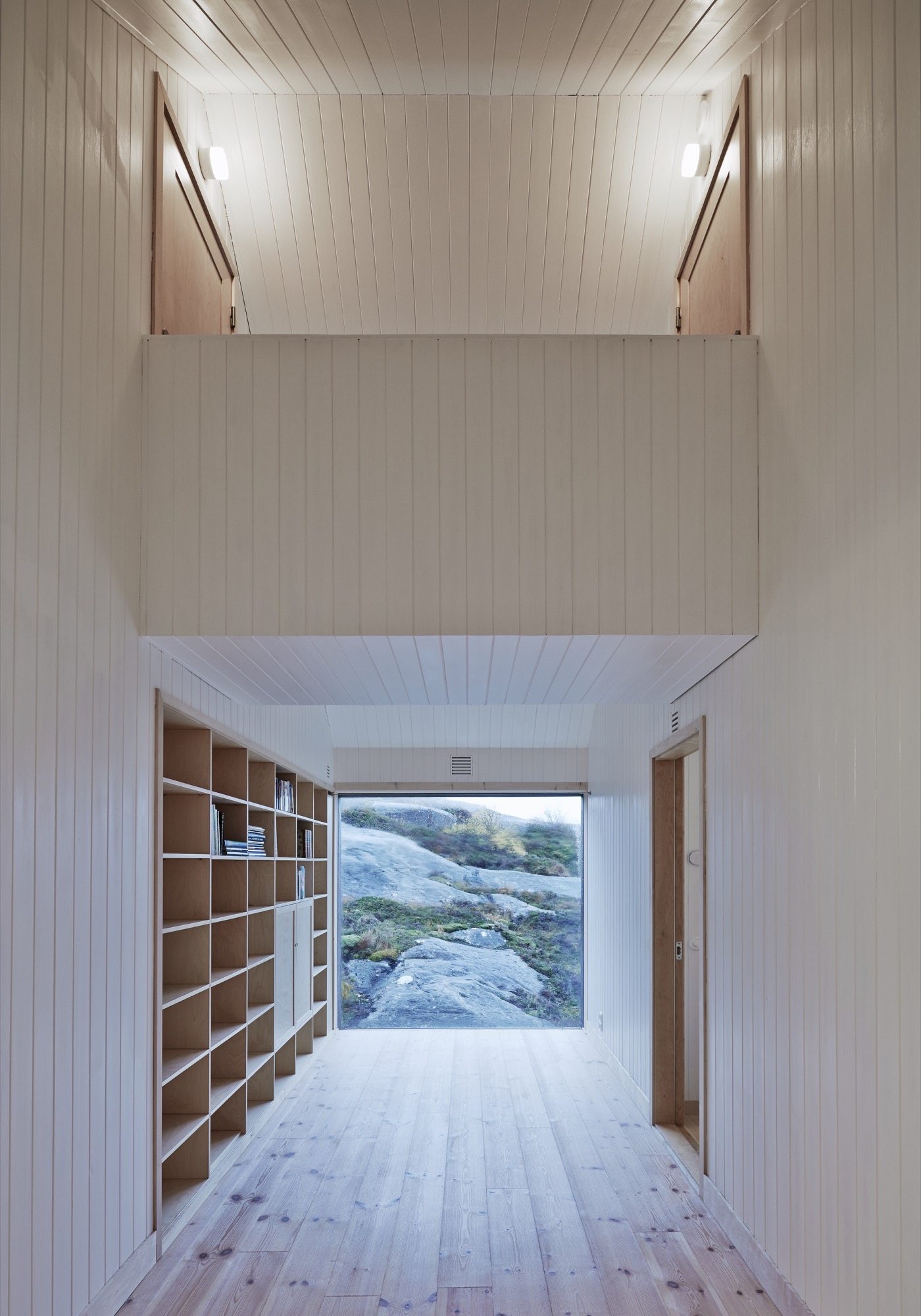
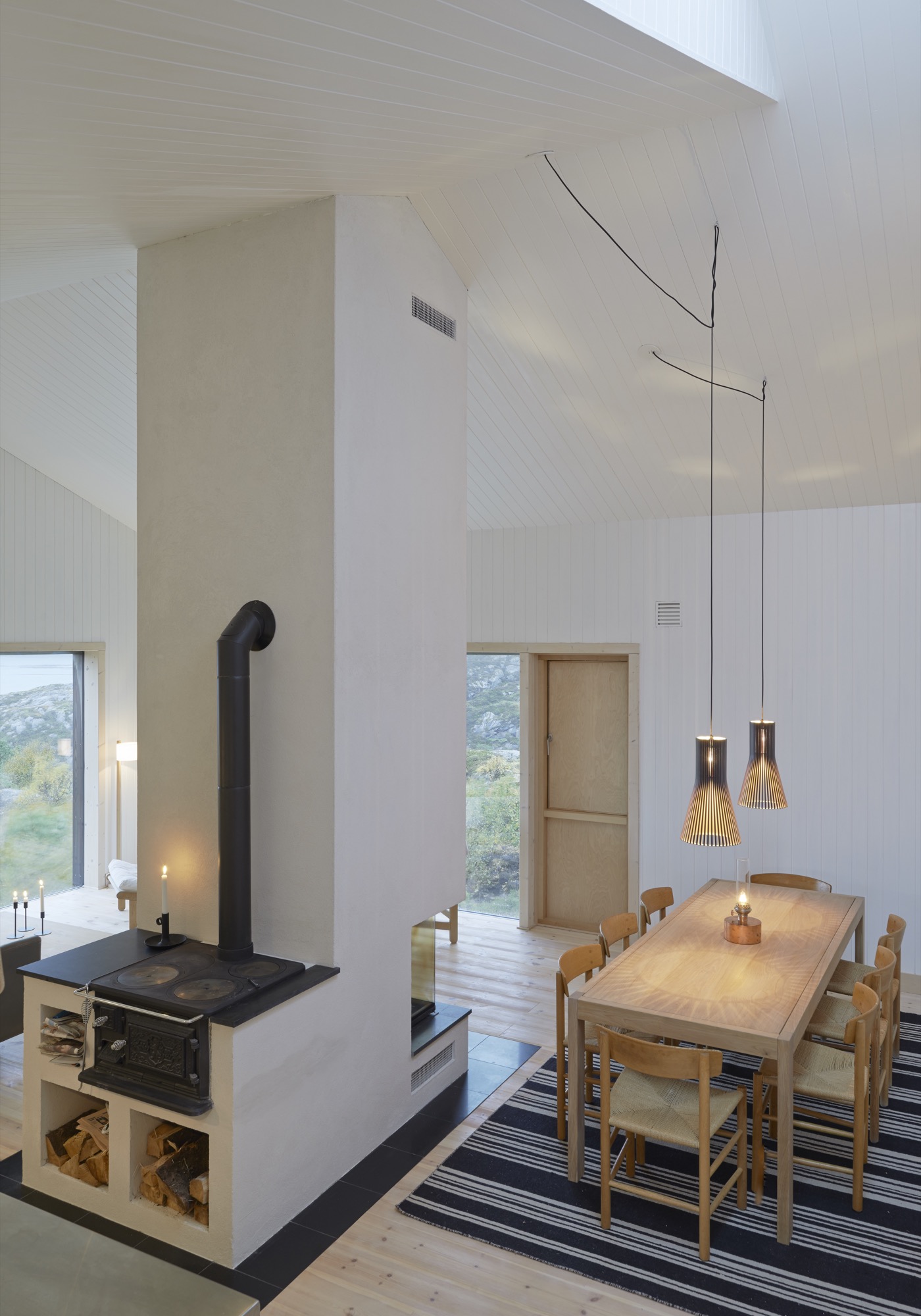
The Right Stuff
Kolman met his client through a mutual acquaintance in Stockholm. Mørk-Eidem had been looking for someone to build the house for quite some time. Realizing what a challenge it would be on this particular site, he pictured someone young, eager to take on the assignment for the experience, and Kolman fit the bill.
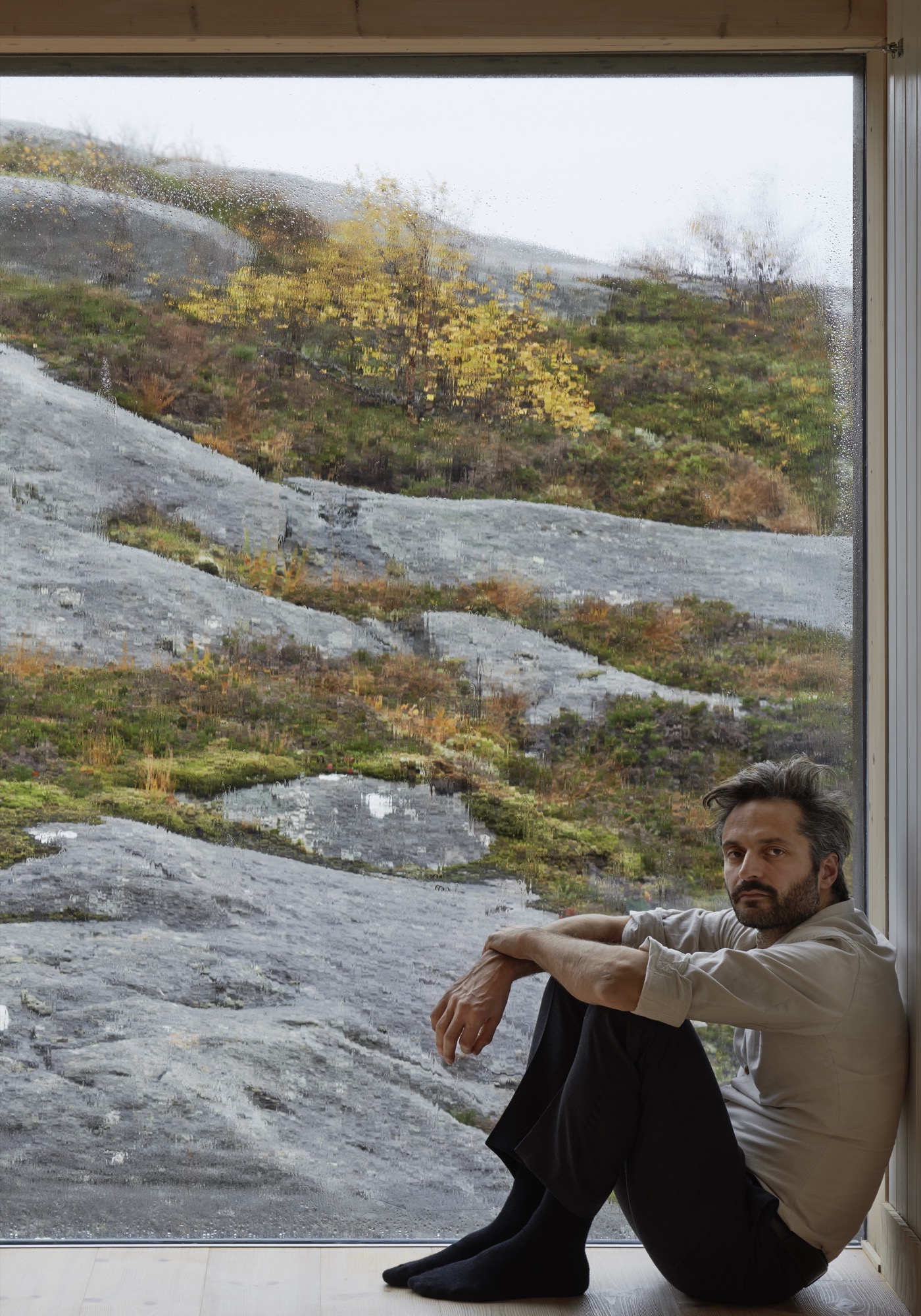
In addition to being one of the partners of Kolman Boye Architects, Kolman also runs a construction firm. A lucky combination since all the contractors Mørk-Eidem approached for a tender had simply refused to answer. “There was nobody who could see any joy in trying to do the impossible,” Mørk-Eidem explains.
Kolman proved to be different. In the Vega Cottage he saw nothing but an enticing challenge. Building the house on Vega was possible, but it took five years and twenty-three Stockholm-Vega round-trips by car for the architect. A total distance, he figures, that roughly equals a trip around the equator. True or not, one trip by car from Stockholm to Vega is long, time-consuming, and not very pleasant.
“It was really important to build the house without doing any damage to the landscape and to make it appear as if the house had always stood on this site,” Kolman says. “What fascinates most people who come here is that you get the feeling that it’s grown out of the bedrock.”
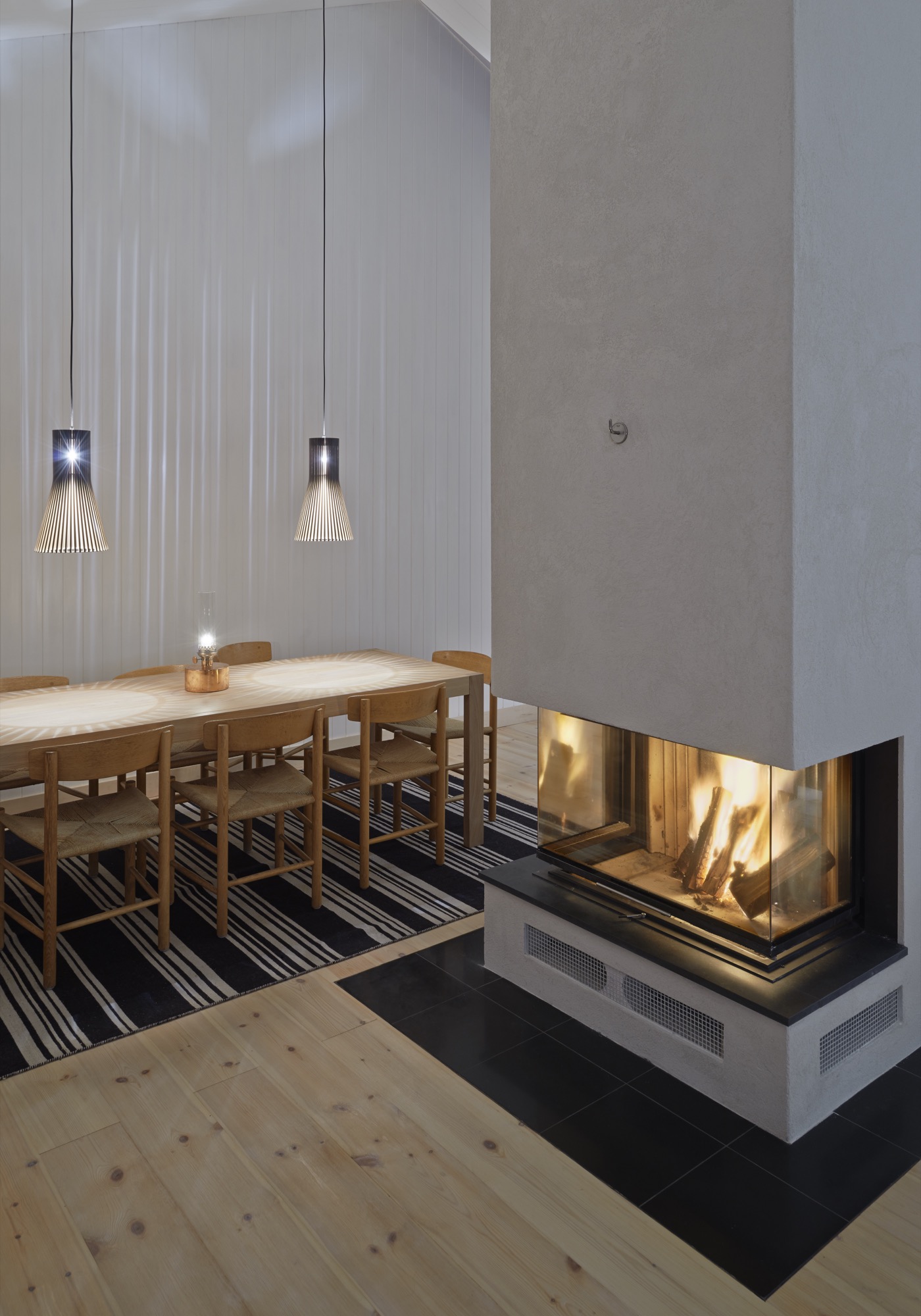
Building on the bedrock and being gentle with the landscape also made the construction difficult. A road had to be built to the site, and building material laboriously towed over the bedrock the house stands on—not to mention the efforts to transport and install the windows. The panes are 40 millimeters (1.57 inches) thick to withstand the storms and high winds that would shake and shatter thinner glass. Residents can enjoy the spectacle outside from a quiet, warm, and cozy house, cheered by the hearth that is the heart of the lower-level’s social area. “They’re not something you can break easily,” Kolman says about the windows. “In fact, you can jump on them and nothing will happen.” Staying at the Vega Cottage, I was glad the project was graced with such a persistent architect-builder—the landscape is beautiful, but I was happy to keep the elements of nature where they belong—on the other side of the glass.
“It was really important to build the house without doing any damage to the landscape and to make it appear as if the house has always stood on this site.”
Other than the pitched roof, this is a rather minimalistic house—or as Kolman says, “There is nothing that juts out, so there is nothing for the wind to grab on to.”
There is not even a railing around the terrace outside the lower level’s two bedrooms. “My sister wondered when they would be put in place,” Mørk-Eidem says. “They never will be,” he declares, adding, “This is a childproof house in the sense that nothing can be broken.”
If nothing can get broken, theoretically nothing will need to be fixed. To keep maintenance on the house to a minimum during holidays and vacations, Mørk-Eidem and his architect opted for weatherproof solutions for the house. At one stage in the project they considered black facades. But when I visited, a year after completion, the unpainted facades, which were only treated, already had their gray patina. Houses age fast on Vega.
“Houses age fast on Vega.”
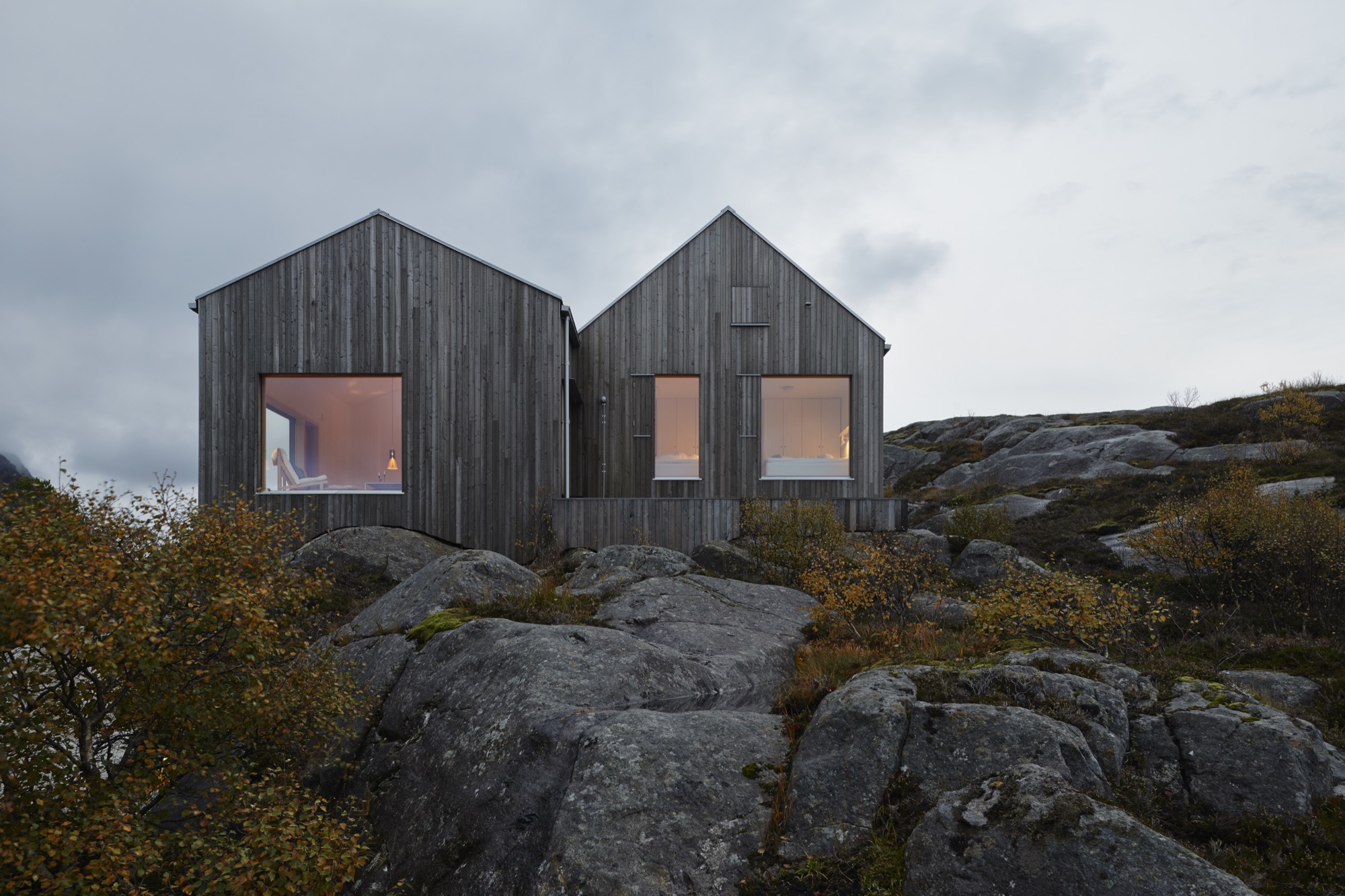
The cottage owes much to vernacular architecture, but the local building tradition has always emphasized protection from the elements of nature. The island’s old buildings, placed wherever there is shelter from the storms, all turn their backs to nature and to the extreme weather. “You get very unsentimental living out here,” Mørk-Eidem tells me. “You get used to this nature, and you look at it as a kind of antagonist.”
“You get very unsentimental living out here.”
He proceeds to tell how his father reacted when he first came to the house. As an adult, Mørk-Eidem senior moved to Oslo and hadn’t lived on the island for decades. “At first, he was suspicious,” Mørk-Eidem recalls, “because he’s never been used to sitting inside and just admiring the view. For him it was a really different experience to come to a place he knows so well but to see it from an entirely new perspective.”
Hearing that this outpost can give even natives new perspectives is a testament to the qualities of this house that makes the architect say, without the slightest hesitation, that he would gladly take on the logistical and psychological challenges of an assignment like this again. △
